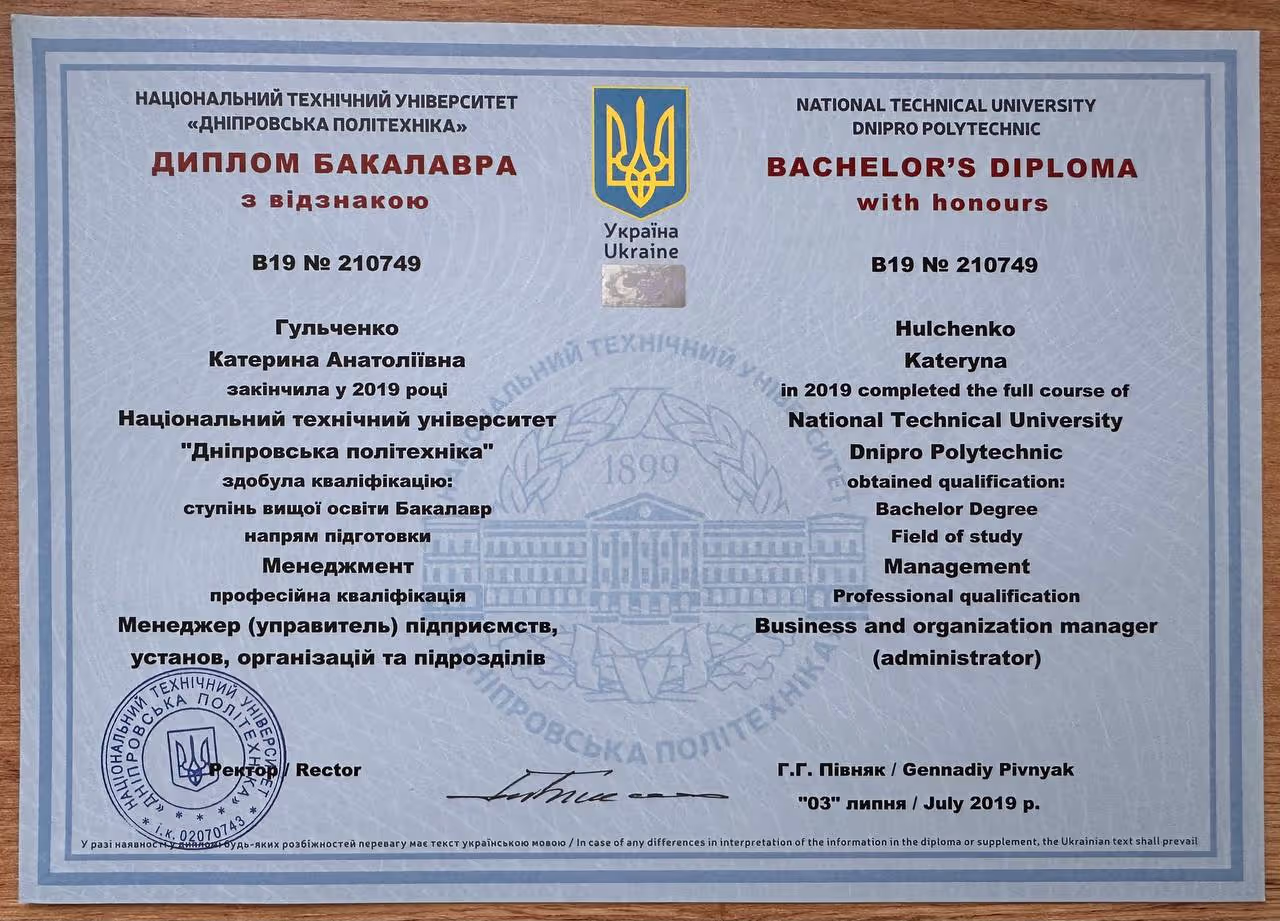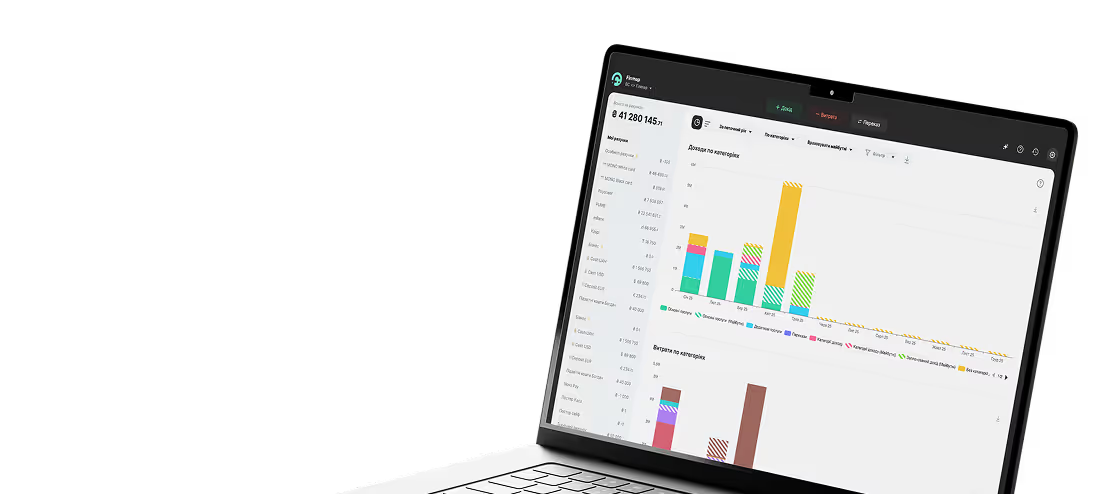Author's Posts
.webp)
Seasonality in Business: How to Predict Financial Fluctuations and Avoid Crises
Discover how seasonality affects your company’s cash flow — and how Finmap helps you stay financially stable all year round
After every successful period comes a downturn — and you start looking for the reason again: clients seem less active, ads don’t work, the market has changed.
Sounds familiar? It happens even to experienced entrepreneurs.
But maybe the issue isn’t that your business is “unstable.” Maybe it’s simply seasonal — and you just haven’t factored that into your financial planning yet.
Let’s figure out what seasonality really is, why it affects your finances, and how to make demand fluctuations work for your business, not against it.
What Is Seasonality and Why It Affects Business Finances
Seasonality is the regular fluctuation of sales, demand, or expenses that repeats throughout the year.
Almost every business feels it:
- in retail — spikes before the holidays;
- in construction — activity in spring and summer;
- in services — vacation or holiday periods;
- in manufacturing — client order cycles;
- in e-commerce — peaks during sales and holiday campaigns.
It’s a natural phenomenon, but it significantly affects cash flow, inventory, team workload, and profitability.
That’s why the main goal of a business owner is not to avoid seasonality, but to learn how to account for it.
Why Seasonality Can Be a Risk
Many entrepreneurs ignore seasonal patterns, considering them “minor fluctuations.”
In some key industries — including retail, tourism, and agriculture — up to 70% of annual revenue comes from just a few months of peak season. — SCORE, official partner of the U.S. Small Business Administration (SBA)
This means that just a few months can determine the financial outcome of the entire year.
If seasonality is not factored into planning, a business risks losing stability even after its most successful period.
As a result, companies face typical financial problems:
- Cash gaps. During sales downturns, income isn’t enough to cover fixed expenses — rent, salaries, taxes. Even a profitable business can temporarily run out of funding.
- Excess purchases or product shortages. Without demand forecasting, you can either overstock (and freeze money in inventory) or run out of goods during peak sales.
- Team overload or downtime. During high season, the team can’t keep up; during low season, it’s underutilized — but salaries still need to be paid.
- Poor management decisions. Looking at finances only month by month, without considering seasonal cycles, can lead to wrong conclusions — like cutting the budget just when it’s time to invest in preparing for peak sales.
- Missed growth opportunities. Without seasonality analytics, a business focuses only on survival instead of using peak months for scaling — launching new products, increasing average check, or attracting investments.
Why It’s Important to Account for Seasonality in Financial Management
- For forecasting. Seasonality helps anticipate in advance when income will rise or fall — and prepare for it financially.
- For planning. Knowing when a downturn is expected allows you to create reserves in advance, adjust budgets, and avoid cash gaps.
- For expense optimization. Analyzing seasonal fluctuations shows which costs can be temporarily reduced and which should be strengthened during peak periods (for example, marketing, logistics, or procurement).
- For stability. A business that understands its financial cycles doesn’t react chaotically but manages cash flow consciously. This means less stress, more predictability, and a clear financial strategy for the entire year.
- For data-driven decision-making. When seasonal trends are recorded in numbers, management decisions stop being intuitive. The owner sees the full picture — which months bring the main profit, when to scale, and when to control spending.
How to Check How Much Your Business Depends on Seasonal Fluctuations
Seasonality can manifest in different ways, and business owners often notice it only after the fact — when there’s suddenly not enough money in the account and the number of clients drops.
That’s how financial stress begins — the kind that could have been predicted if you knew exactly when your business depends on seasonal fluctuations.
Don’t wait until the numbers tell you that something’s wrong.
Take a quick test and find out:
- whether your business has seasonality;
- how much it affects your money;
- and how you can influence it.
Does Your Business Depend on Seasonality?
Answer “yes” or “no” to the following questions to determine how much your business depends on seasonality.
At the end, count the number of “yes” answers — the result will show your level of seasonal dependency and help you understand how to plan your finances more effectively.
How to Calculate the Result
0–4 “yes” — minimal seasonality. Your business has stable demand and steady sales throughout the year.
Recommendations:
- Keep a record of income and expenses to track long-term trends — markets and customer behavior change over time.
- Monitor your margins to understand the real profitability of each business direction.
- Automate your financial management in Finmap to avoid errors and save time on manual calculations.
5–9 “yes” — moderate seasonality. Your business partly reacts to seasonal changes or events, so it’s important to plan your cash flow in advance.
Recommendations:
- Create a financial forecast at least 3 months ahead.
- Build a reserve fund to cover low-sales periods.
- Analyze your revenue trends in the Cash Flow report in Finmap to clearly see when peak and “quiet” months occur.
10+ “yes” — high seasonality. Your business shows strong demand cycles. Without financial flow planning, regular cash gaps are likely.
Recommendations:
- Create a quarterly budget with income and expense forecasts.
- Allocate part of your profit to reserves for fixed costs (rent, salaries, taxes).
- Use the Plan/Fact report to spot deviations from your budget in time.
- Review your marketing strategy: maximize sales during peak months, and focus on efficiency during slow periods.
Financial Management Features for Seasonal and Non-Seasonal Businesses
Seasonality is not only about sales — it’s about how cash flow changes throughout the year.
In financial management, the difference between a seasonal and a stable business is significant — it determines the strategy for planning, budgeting, and building reserves.
How Financial Management Works in a Seasonal Business
- Irregular cash flow. Profits come in waves: peak months (holidays, tourist season) alternate with “quiet” ones. That’s why the owner needs to forecast cash to cover expenses during downturns.
- Planning by periods, not just by income. In Finmap, it’s important not only to record transactions, but also to forecast when income and expenses are expected. This allows you to allocate profit wisely — part for growth, part for reserves.
- Reserve fund as a must. In seasonal businesses, profitable periods should cover the off-season. The key metric is not monthly profit, but annual average profitability.
- Separate fixed and variable expenses. This helps you see which costs remain constant even during slow months (rent, utilities, admin salaries) and plan reserves accordingly.
- Analyze seasonal trends. The Cash Flow chart in Finmap helps visualize recurring sales peaks and adapt purchasing, inventory, and marketing plans.
This not only helps you stay stable, but also turns seasonality into an advantage — for example, by focusing marketing efforts when demand grows.
How Financial Management Works in a Non-Seasonal Business
- Stable cash flow. Income and expenses remain consistent throughout the year, allowing for simpler budgeting without the need for large reserves.
- Focus on efficiency. Such businesses prioritize the profitability of each direction, margin control, and cost optimization.
- Reserves are still necessary, but smaller. Even with stable sales, short-term disruptions can occur — for example, client payment delays. A reserve covering 1–2 months of expenses is enough to create a safe operational buffer.
- Strategic growth through analytics. In non-seasonal businesses, there’s more room for detailed analytics: comparing profitability across directions, identifying the most effective sales channels, and optimizing expenses.
- Continuous focus on marketing. Without natural seasonal demand spikes, marketing must run continuously. Owners should regularly analyze campaign performance to maintain stable sales levels and avoid gradual decline.
Comparison: Seasonal vs. Non-Seasonal Business
Seasonality is not a threat — it’s a sign of a mature business.
Those who can anticipate their cycles turn peaks into profit and slow periods into opportunities for growth.
Which Tools Help Track Seasonality
To understand how your business changes throughout the year, you need not just numbers — but dynamics: seeing when sales grow, expenses increase, and cash gaps appear.
In Finmap, this can be done using several tools that reveal seasonal fluctuations from different perspectives.
1. “Cash Flow” Report
The main tool for identifying seasonal patterns. The chart clearly shows how cash movements change month by month — income, expenses, and balances.
If certain months consistently show a rise or decline, that’s a clear indicator of seasonality.
Regular analysis helps you identify which periods are the most profitable and when it’s time to build up reserves.
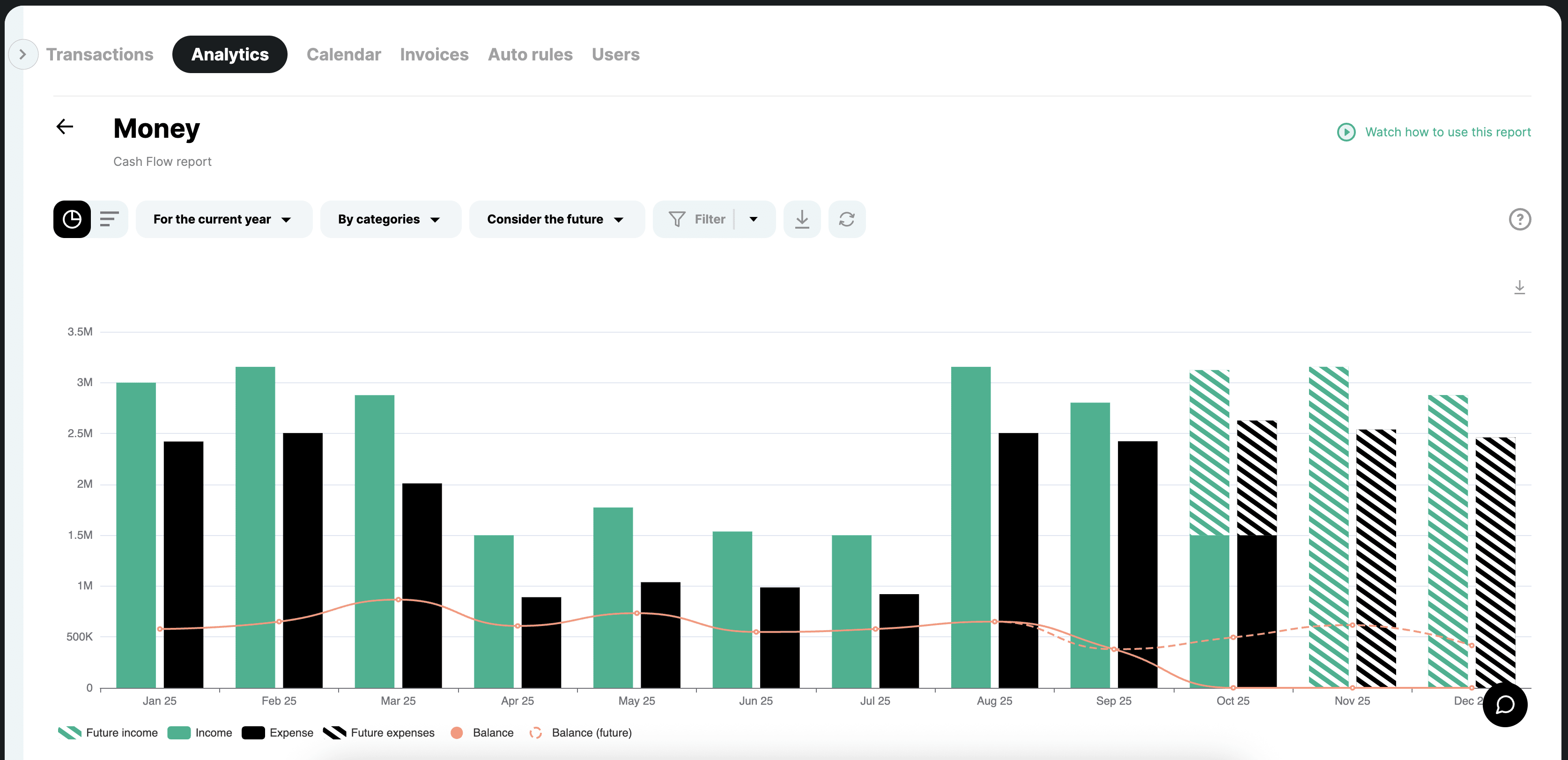
2. “Inventory” Account
For businesses that manage stock, seasonality often appears in purchasing patterns and inventory levels.
By tracking inventory in monetary terms, you can see when cash is “frozen” in stock and when active sales occur.
This helps not only to control inventory turnover, but also to plan purchases for seasonal demand — without losing liquidity.
3. Planned Payments and Payment Calendar
Payment planning helps you prepare for the off-season in advance. The calendar shows when major expenses or inflows are expected and allows you to assess whether there will be enough funds to cover them.
This enables the business to distribute cash flow more evenly throughout the year and avoid liquidity gaps.
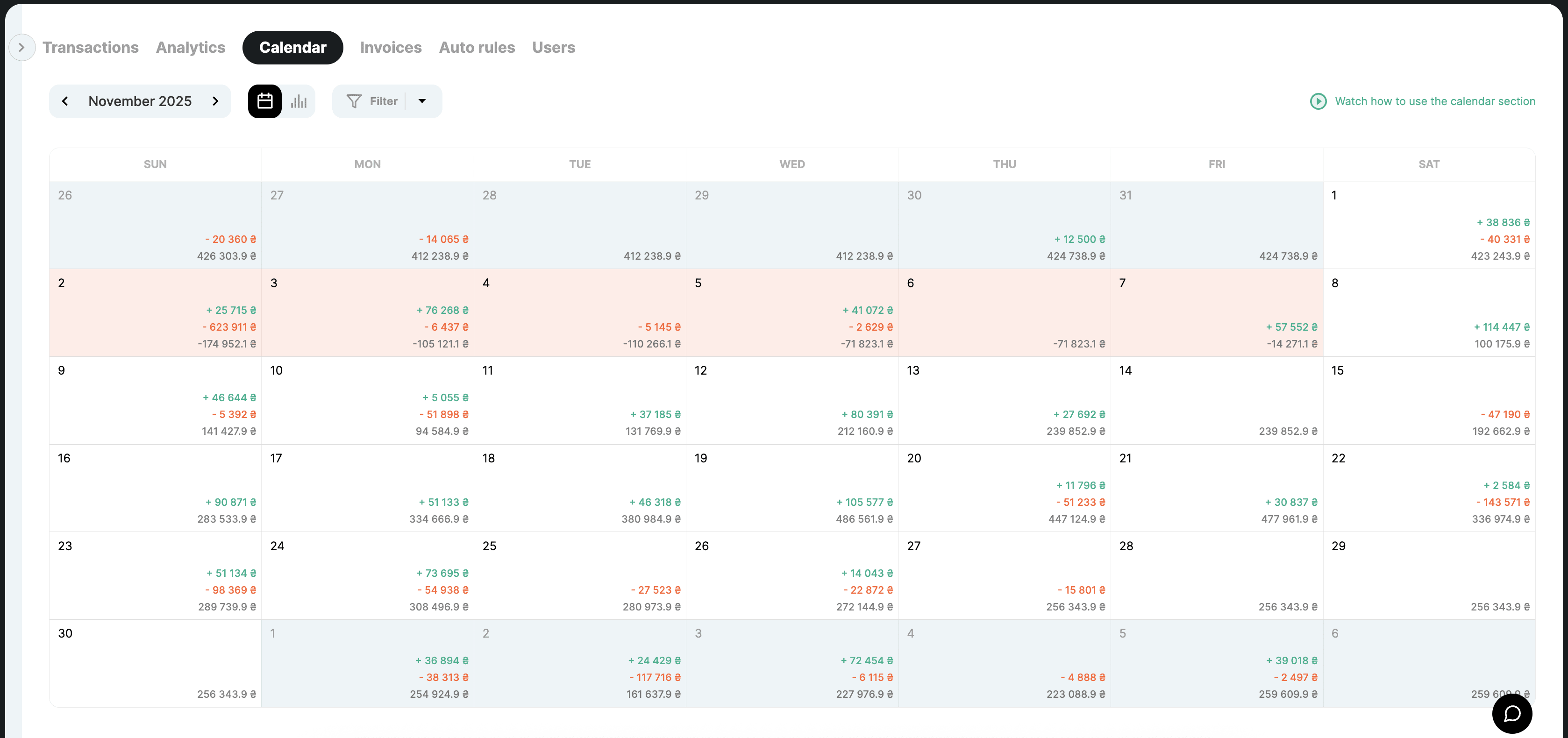
4. “Plan/Fact” Report
Comparing planned figures with actual results helps identify how seasonality affects budget performance.
If income in certain months significantly deviates from the forecast, this may indicate a seasonal factor.
Analyzing such deviations allows you to adjust your financial plan and better predict similar fluctuations in the future.
Tips for Businesses with Strong Seasonality
Seasonality isn’t just about revenue changes — it’s about shifts in the overall rhythm of the business.
When demand rises, you need to scale quickly; when it falls, you need to stay efficient.
To maintain balance between peaks and slow periods, it’s essential to have a systematic approach to finance, marketing, and operations.
Key Areas, Actions, and Management Decisions for Seasonal Businesses
You can’t eliminate seasonality — but you can calculate it, anticipate it, and turn it to your advantage.
When financial decisions are based on data rather than intuition, seasonality stops being a risk and becomes part of your strategy.
That’s exactly why Finmap was created — to help entrepreneurs see the full picture of their cash flow, plan ahead, and stay stable in any season.
Connect Finmap and turn seasonality from a source of stress into a source of growth!
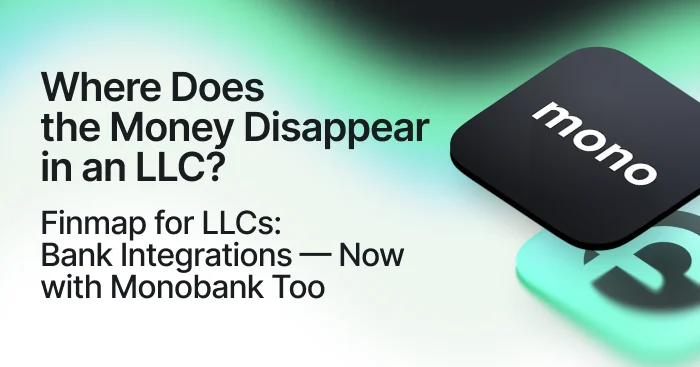
Bank Integrations for LLCs: A New Opportunity in Finmap With Monobank
Don't understand where the money from your LLC is going? The solution is Finmap with bank integrations, including Monobank. Control your finances without Excel.
“We were working at a profit. But our account balance is zero. Where did the money go?” This question stumps many LLC owners. Everything is working: the team, the product, sales — but at some point, there is simply not enough money. Not enough for salaries. Not enough for taxes. Not enough for purchases. A cash gap arises, and the business finds itself on the brink.
The pain is that you don't even see where exactly you are losing.
The accountant says the reports will be ready next month. The Excel spreadsheets haven't been updated in weeks. Money is scattered across accounts, contractors, employee cards — and it's difficult to piece it all together into a single picture.
Why Is This Critical for LLCs?
Businesses operating as LLCs are often complex structures: multiple accounts, departments, and directions.This is not “self-employment” — this is a system. And a system requires precision.
86% of LLC owners have these problems:
- No single system — they have to track cash, expenses, orders, and inventory in different places.Chaos in accounting — it’s impossible to consolidate all financial data in one place.
- It’s unclear which directions are profitable and which are dragging the business down.
- Excel can’t handle it anymore — routine tasks, exports, copy-pasting, mistakes.
- No clarity on whether the business is profitable or if dividends can be paid.
- Financial accounting is not automated.It’s hard to estimate the costs of opening a new location — everything is done “by feel.
- ”There’s no strong finance expert, or they are overloaded / not familiar with the business.
- A turnkey solution is needed — not just another finance course.
And instead of running the business, you turn into a financial analyst — or just close your eyes to the numbers.
How It Works in Practice
Financial accounting for LLCs is not about reports for the sake of reports, but about decisions that change business. Below are examples of companies that saw real figures and were able to make effective decisions thanks to Finmap.
Construction Company: “They Ate Themselves”
The company had six areas of focus: residential construction projects, commercial construction, and repair crews. Thanks to Finmap, they discovered that one area was eating into the profits of two others. Abandoning the unprofitable model resulted in a gain of 410,000 UAH over three months.
E-Commerce With Its Own Warehouse
The owner of a retail business that sells through Rozetka, Prom, and its own website has consolidated all expenses, orders, balances, and payments in one place. This saves over 40 hours per month, as previously all of this was managed in Google Sheets.
Education Business: Emigration School
The Finmap financial model revealed that lead acquisition costs exceed average revenue per customer. Sales department optimization resulted in a 22% increase in quarterly margins.
The statistics speak for themselves:
- 82% of LLC entrepreneurs in the small and medium business segment experience a lack of quality management accounting tools (according to a Finmap survey, 2024).
- Finance automation allows reducing time spent on routine tasks to 10 hours per month.
- Businesses that implement bank integrations with accounting systems increase financial transparency and make decisions twice as fast.
Finmap Integration With Monobank LLC — An Example of Automation Without Headaches
The new partnership between Finmap and Monobank for LLCs is a perfect example of effective business automation. This means that now all transactions appear in Finmap automatically. No exports. No errors. In real time.
The pain of manual data entry is in the past. Now LLC owners using Monobank can connect their accounts to Finmap, and the data will be updated automatically, without any extra actions on your part.
Previously, LLC owners with Monobank accounts couldn’t automatically pull statements into Finmap. Now, everything works simply and intuitively, just like it does with personal accounts.
How it works:
- In Finmap, click “Add integration”.
- Select Monobank LLC.
- If you are abroad, select Ukraine as the country, then Monobank LLC.

- Select an account, choose the period from which to pull data, and follow the instructions.
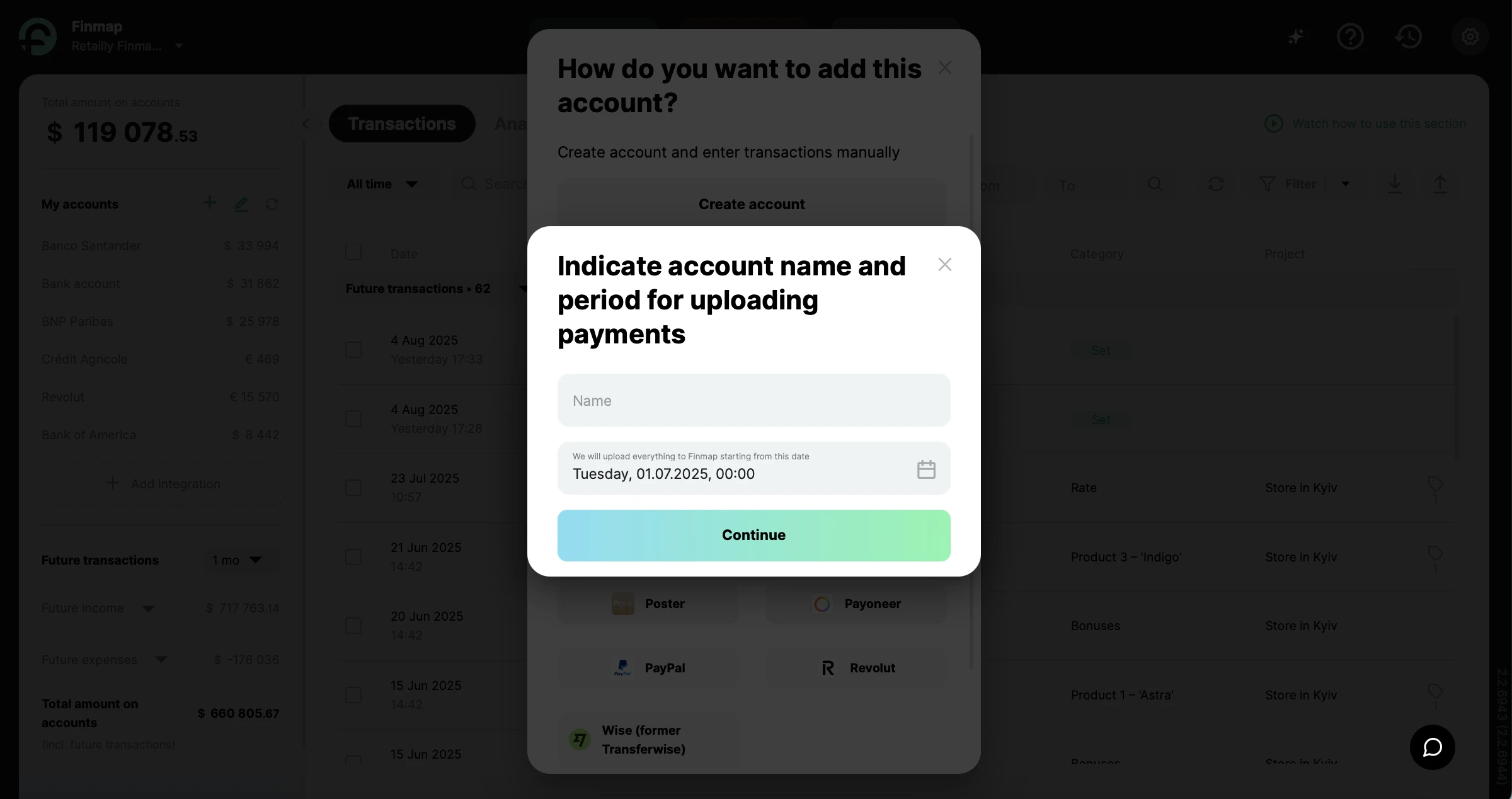
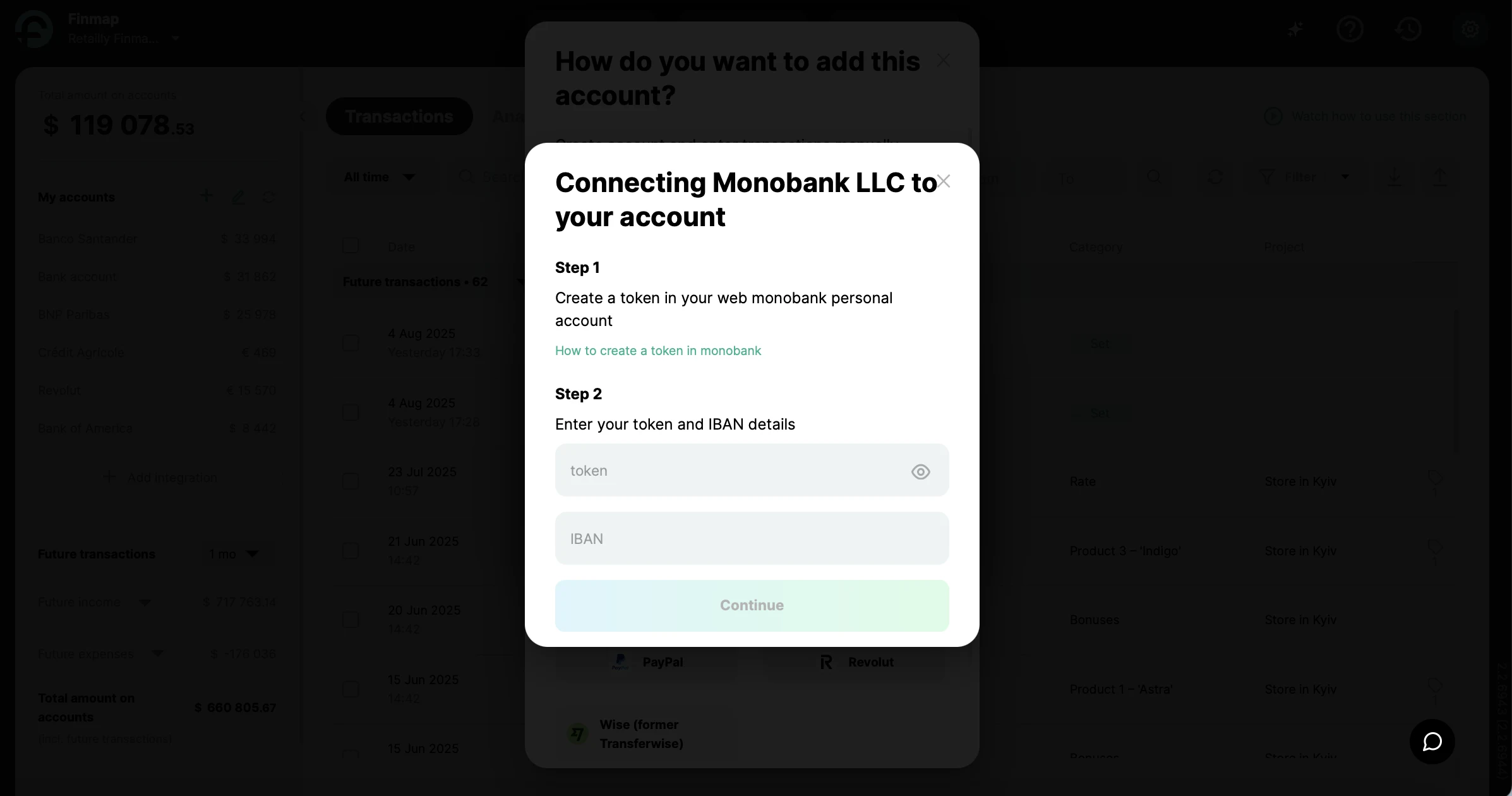
Bank integrations with Finmap solve a number of problems for LLC owners:
- Finmap collects all income, expenses, accounts, cash, debts, and investments in one system. The data is updated automatically. Excel is in the past.
- When you have a project-based business, you need to see what is profitable and what is dragging you down. In Finmap, you can break down accounting by legal entities, departments, or directions.
- Previously, LLC owners using Monobank had to export statements manually. Now — they don’t. Data is pulled automatically, just like for sole proprietors. No errors. No extra steps.
- The financial manager has access to all the necessary data for their work, the department head sees only the information related to their unit, and the partner sees only the data related to their share. Full control over access rights.
- You don’t need a CFO or to understand budgeting. Finmap provides outsourced CFO services who will set up accounting tailored to your business.
Who is this solution for:
- For owners of small and medium-sized businesses who manage LLC accounts in Monobank.
- For those who want to see up-to-date financial data without extra effort.
- For entrepreneurs who need to react quickly to changes in cash flow.
What else does a business get with Finmap:
- Over 2,800 bank integrations worldwide
- Support for 114 currencies and 138 cryptocurrencies
- Bank-level security — 256-bit encryption, data stored on European servers
- Automatic analysis of cash flow, P&L, balance sheet, receivables and payables
Now for the Main Point: Why Integration With Monobank LLC Is a Must-Have
- Statement automation — no CSVs or copy-pasting
- Time savings — on average up to 10 hours per month
- Real-time data — you see problems before they become critical
- Less human factor — fewer mistakes
Time to face the truth:
Do your projects generate profit — or just look good in presentations?Do you know how much it costs to open a new location — or is it “we’ll see” again?
How much more time will you spend on manual routine?
Ready to see what financial order looks like?
Finmap integrates with Monobank not only for LLCs but also for sole proprietors, and it supports many other bank integrations — choose comfort and automation for your business. Try the Monobank integration now!
.webp)
How Finmap Helps Construction Businesses Turn Financial Chaos into a Profitable System
In this article, we explore three critical financial issues in construction — from cash gaps to missing accountable funds. We show how Finmap helps bring them under control, boost profit, and make decisions based on numbers rather than intuition.
You can build with quality, on time, even profitably — and still lose money. Not because something went wrong on site, but because your finances remain out of control.
In construction, that’s a classic: the number of projects grows, turnover increases — but at the end of the month, the account is empty, contractors await payment, and the numbers don’t add up.
The reason is simple: without structured financial management, a business doesn’t grow — it breaks down into chaotic processes.
What exactly isn’t working in your construction business finances — and how do you fix it?
Let’s look at three core problems that destroy profit and how to solve them.
.webp)
Problem #1: No Detailed Tracking by Project
In construction, everything revolves around projects. You invest in materials, crews, equipment rental — often across multiple projects at once. But when you try to tally things up, the numbers don’t match. Revenue looks good, but the bank balance is zero.
Job costing — the allocation of costs to specific projects — is a basic tool for building real budgets, analyzing efficiency, and forecasting profitability.
Without project-based management, a business quickly becomes unmanageable:
- It’s hard to say how much a single project actually costs.
- Overruns and budgeting errors are impossible to catch.
- The business scales, but profitability declines.
- There’s no way to analyze margins and make informed decisions.
According to a study published on the MDPI portal:
25% of construction companies may face bankruptcy after just two or three poorly costed projects — due to underestimating labor or materials.
How Finmap Turns Chaos into a Controlled Process
In Finmap, you can manage financials by project and subproject — for example, track foundation, roofing, or interior costs separately within one site.
This allows you to see the financial picture not just across the business as a whole, but per project: where overruns occur, which sites are profitable, and which need budget revision.
The system lets you:
- Build a structure of projects and subprojects (e.g. site → subprojects: foundation, interiors, structural work, engineering, etc.).
- Automatically or manually assign and track transactions on the right level.
- Generate key reports — especially P&L and Projects, which provide deep financial analytics.
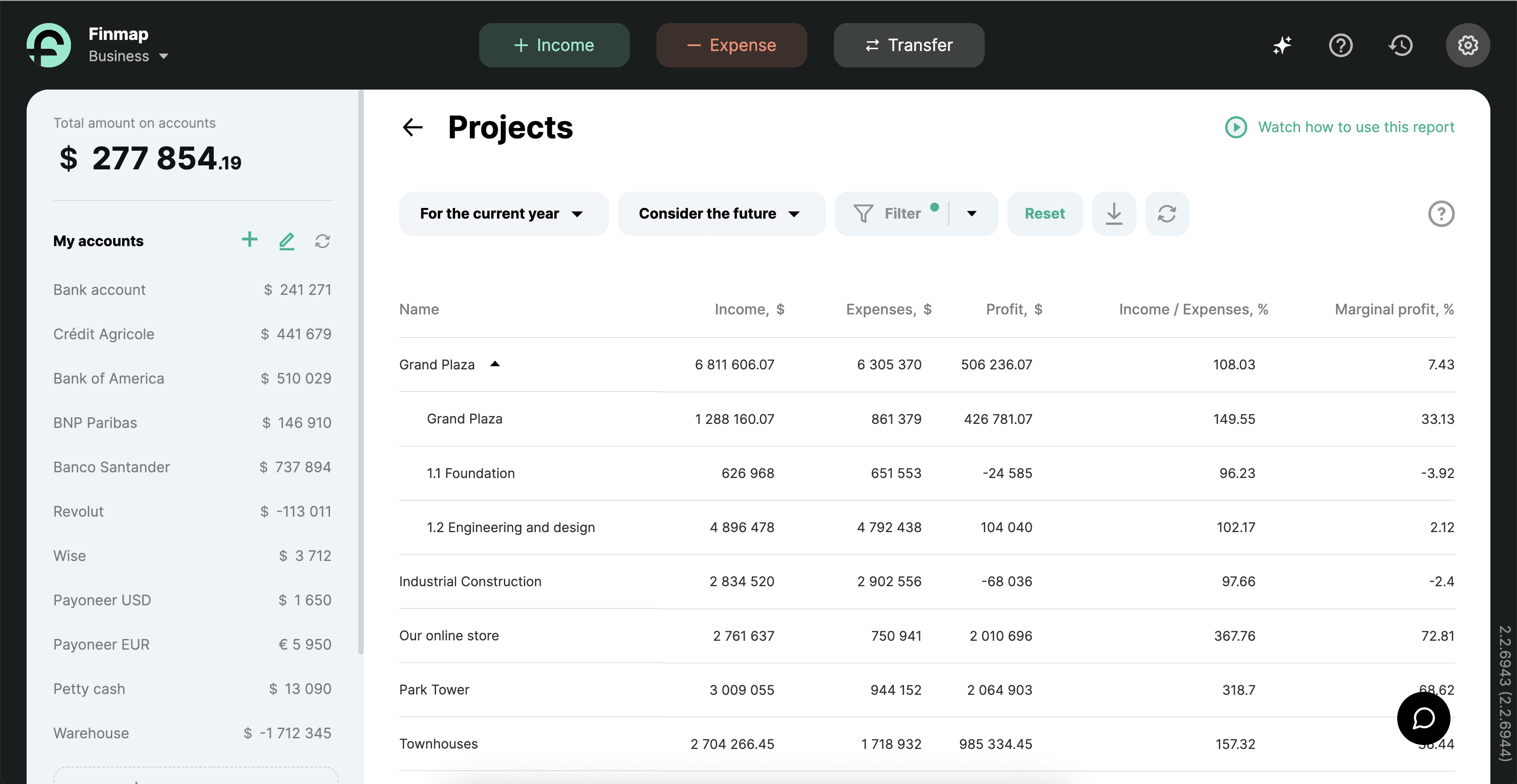
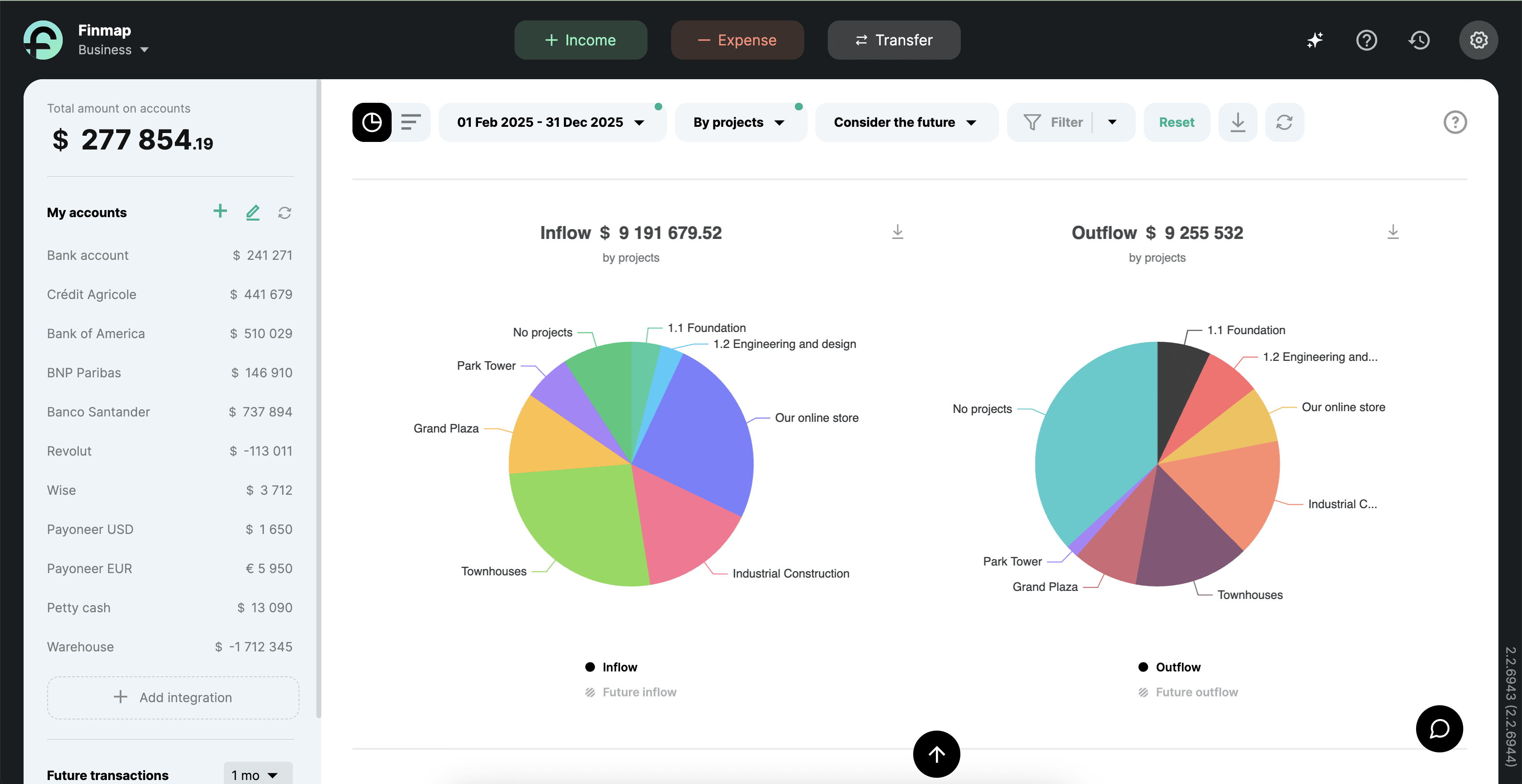
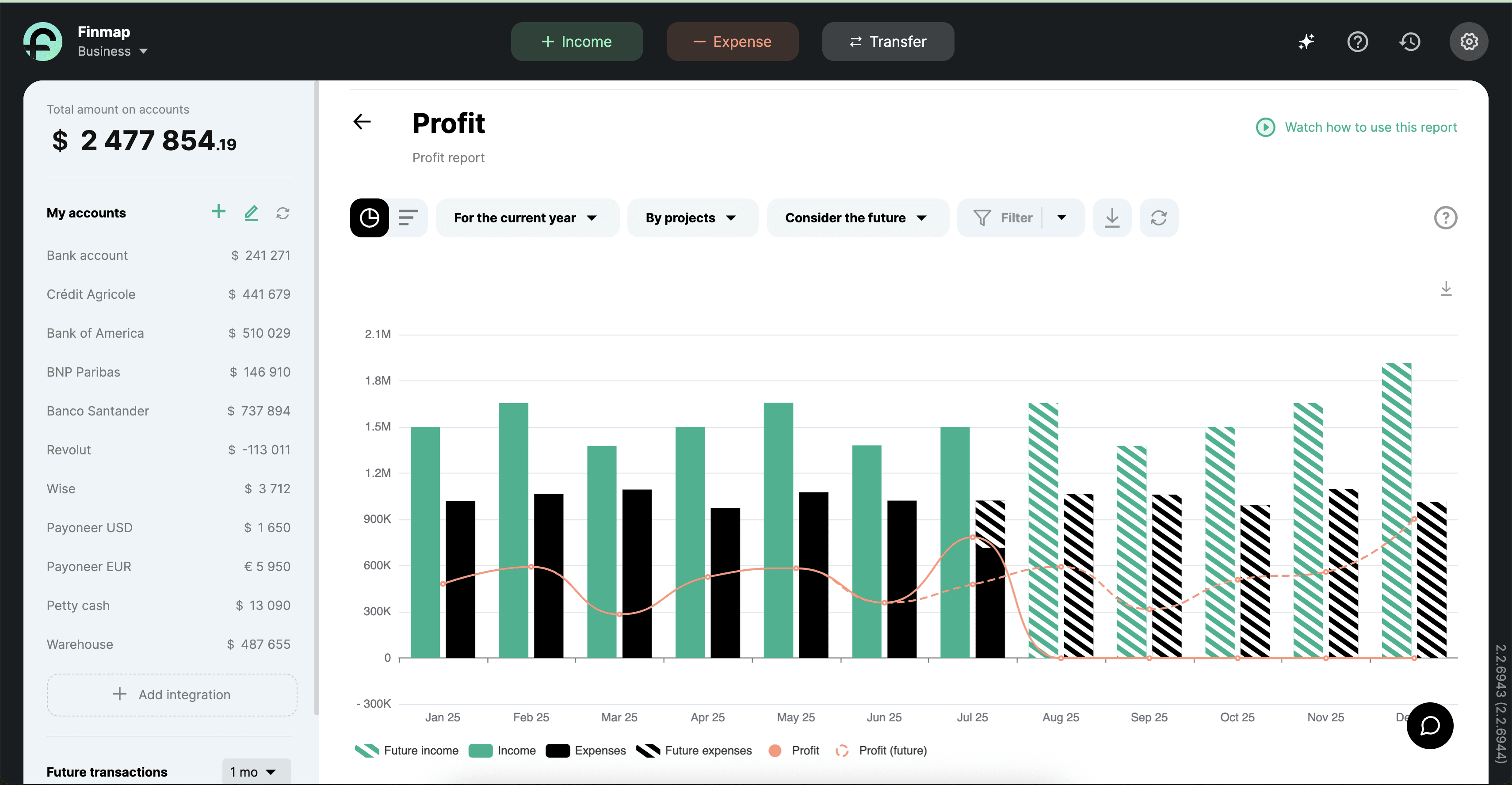
By aligning Finmap’s structure to your real business model, you go beyond tracking costs — you unlock real financial insights.
The system shows key performance metrics — both across the company and per project. Here are suggested benchmark metrics for construction businesses that Finmap helps you track:
Companies using analytics and job costing make decisions faster and more accurately: a research shows that implementing job costing allows 42% faster resource reallocation across projects, improving business agility.
With Finmap, you’re no longer flying blind — the system gives clear, project-specific data so profit becomes a result of management, not luck.
Problem #2: Cash Gaps in Construction — and How to Avoid Sudden Crises
In construction, cash flow gaps aren’t an exception, they’re the norm. You spend heavily upfront: advances to suppliers, prepayments to subcontractors, material purchases.
Income comes later — after completion or with delays.
Without smart financial management, this leads to:
- Cash gaps even in profitable companies.
- No visibility into upcoming financial strain.
- Delays in payments to vendors and employees.
- Loss of trust from contractors and internal teams.
According to Entrepreneur:
Up to 82% of construction businesses go bankrupt due to poor cash flow management — one of the most overlooked risk zones.
Finmap’s Solution: What Changes When a System Is in Place
Finmap doesn’t just show your account balances — it answers the key question: Will you have enough to meet your obligations in the coming weeks?
The core tool is the Payment Calendar, which tracks all upcoming income and expenses by day and giving you early warning of potential shortfalls.
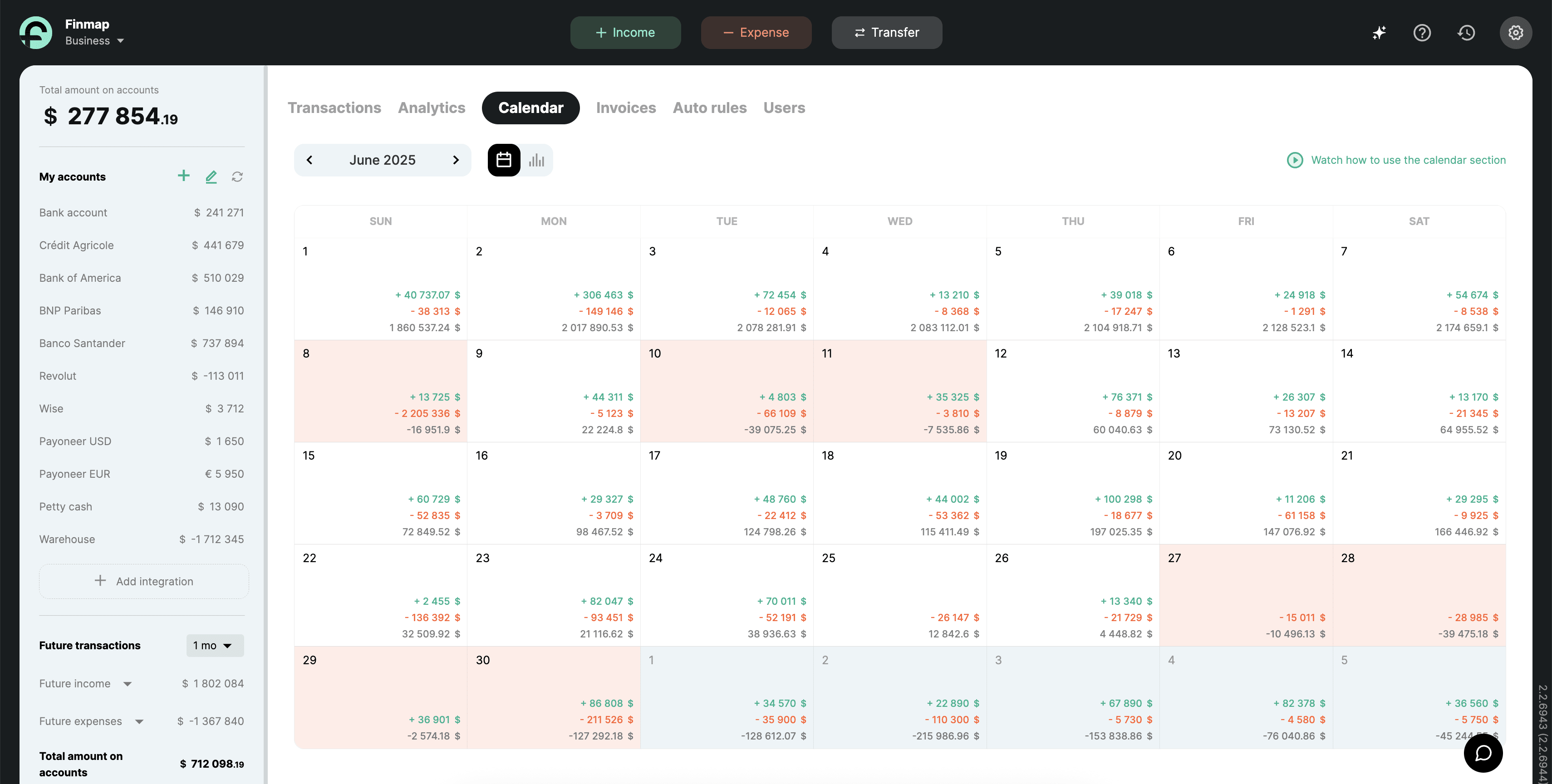
The system lets you:
- Factor scheduled expenses into your financial projections.
- Track expected income (milestone payments, receivables).
- View cash movement by date, account, and project.
- Forecast cash flow and highlight risk periods.
Cash flow forecasts aren’t just reports, they’re early warning systems. Businesses that see what’s coming don’t react, they plan.
In Finmap, this tool works daily — to ensure money doesn’t disappear unexpectedly, but instead drives growth.
Problem #3: When No One Knows Who Owes What to Whom
In construction, financial obligations pile up fast: dozens of contractors, suppliers, advances, partial payments, petty cash.
Without systematic management, this data cannot be combined into a single picture and even the company's manager cannot accurately say how much money is “in circulation,” how much is actually available, and how much is tied up in debt.
Late payments are widespread. According to PYMNTs:
71% of construction subcontractors regularly face payment delays — often due to the lack of structured obligation tracking.
The consequences of disorderly accounts receivable and accounts payable that your business experiences every day:
- No control over receivables or payables.
- No view of real company liquidity.
- “Leaked” petty cash — with no clear trace or accountability.
- Irregular cash pressure, forcing last-minute transfers, credit usage, or personal funding.
Without obligation tracking, you’re not managing money — you’re chasing it. And the bigger the business, the bigger the chaos.
How Finmap Handles This in Real Business Scenarios
Finmap helps you systematically manage receivables and payables via dedicated reports and planning tools that recognize and reconcile operations.
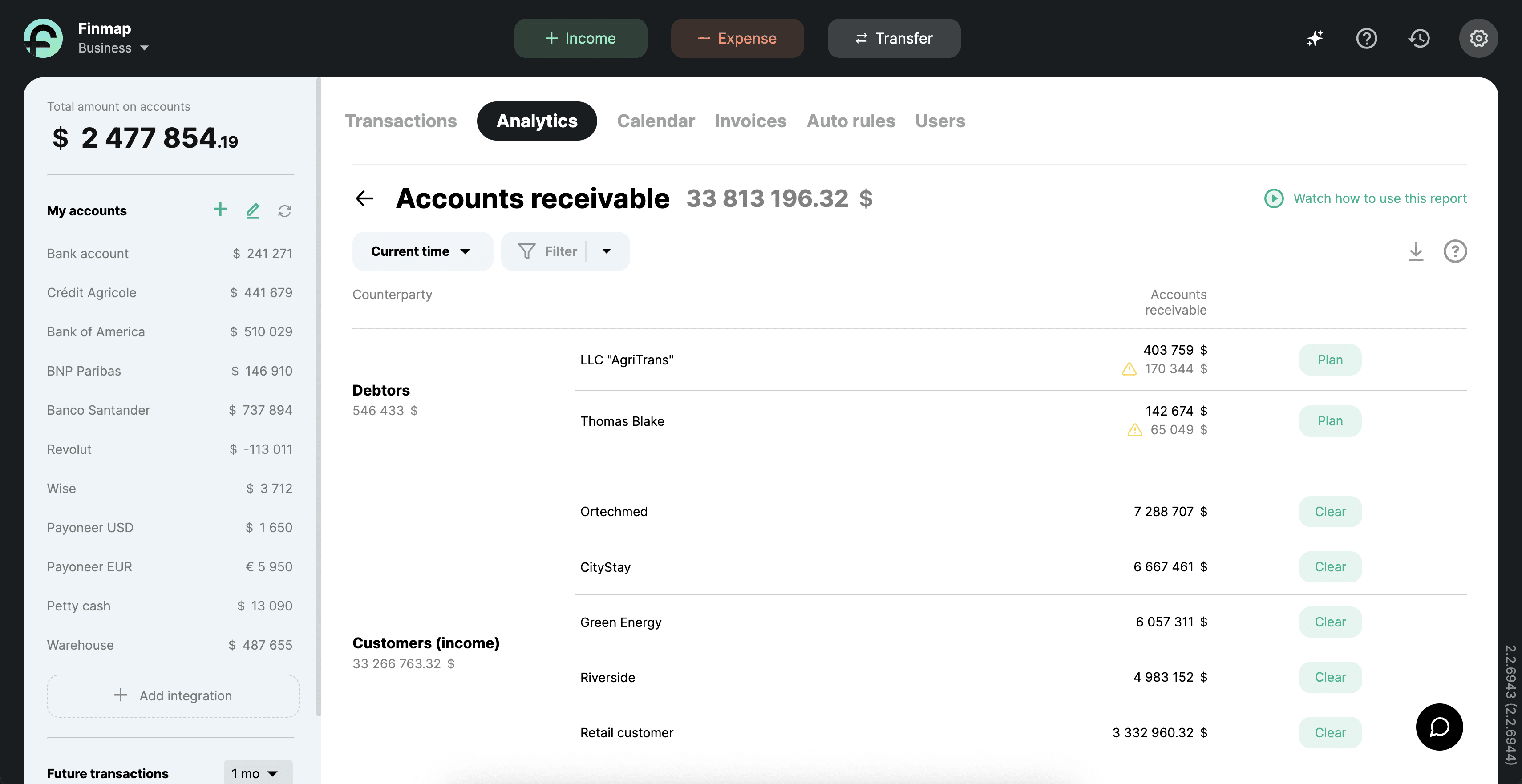
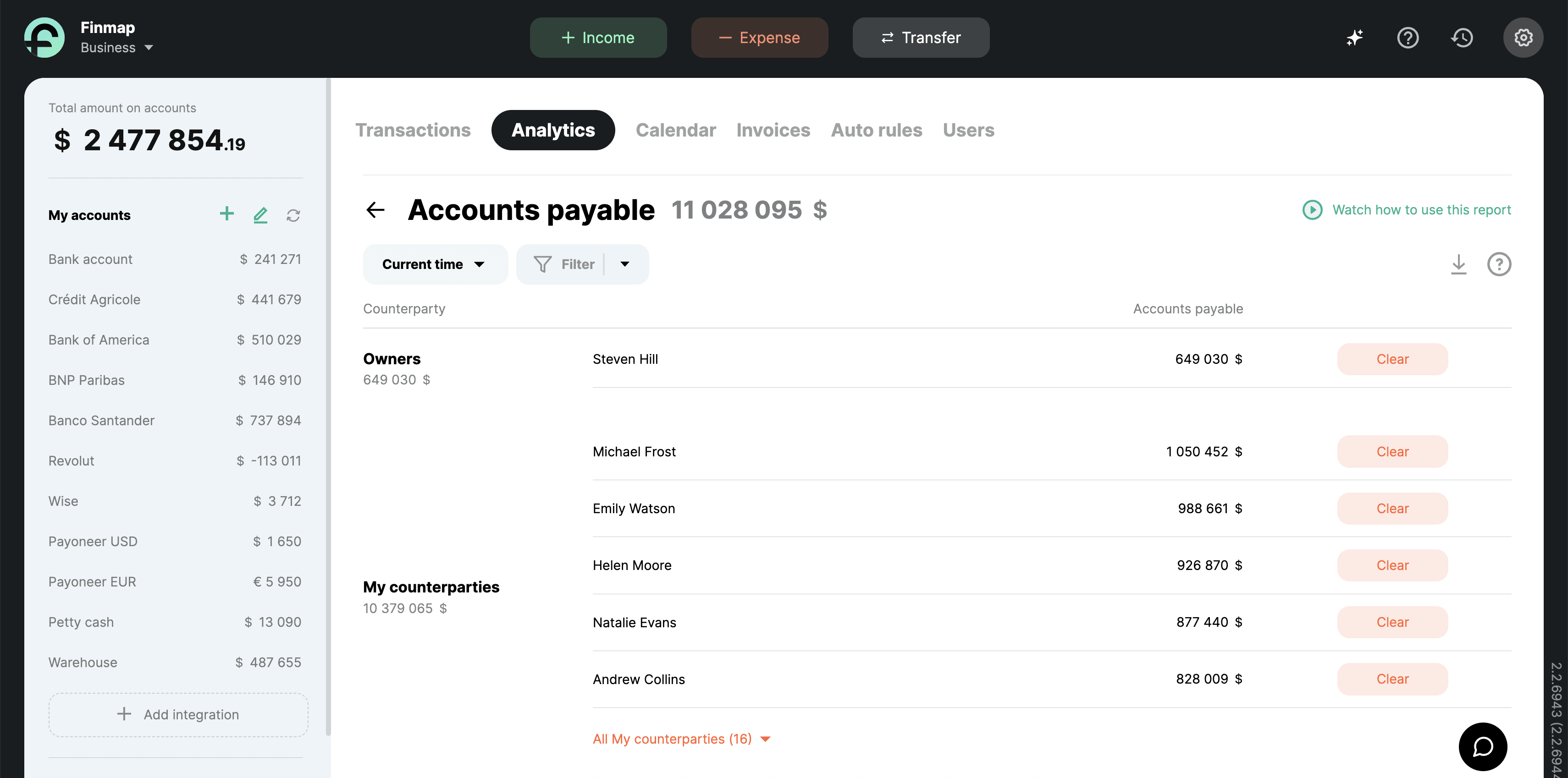
All obligations — future and overdue — are collected in one system, linked to contractors and due dates. The Payment Calendar includes them in forecasts, so you see not just your balance — but the full picture: How much needs to be paid, when, to whom, and from what source.
Petty Cash Management in Construction: a Practical Fix
Petty cash is a “gray zone” in construction: site managers, supervisors, and buyers often receive cash or direct transfers for small purchases, logistics, or repairs.
Without a system, these funds often go untracked or are reported late. So you don’t know:
- What’s been spent.
- What’s still outstanding.
- What was never returned.
Common issues:
- No receipts, or they’re scattered in Viber / Telegram / private chats.
- Some expenses never get logged.
- The cash register “drops,” and no one’s accountable.
- At month-end, reconciling projects is impossible.
In Finmap, you can manage petty cash per employee — with amounts, purpose, project, and closure status.
Here’s a step-by-step framework for gaining control:
If you think petty cash isn’t an issue, and trust alone is enough look at the data provided by Business.com:
67% of employees have violated company expense rules at least once.
ACFE studies show that businesses lose up to 5% of revenue every month due to internal errors, abuse, or simple lack of control.
If your business makes $1,000,000/month — you’re losing $50,000 without even knowing it.
Now multiply that by 12, or 5 years, or 10.
Petty cash isn’t minor. It’s an invisible budget leak, one that grows unless closed systematically.
Finmap Client Case: How an Architect Became a Financial Manager
Bogdanova Bureau is an architecture studio handling full-cycle interior and building projects, with offices in Kyiv and Switzerland. Each project is highly individual with large budgets ($1M to $5M), and responsibility not just for design but for timelines, teams, phases, and costs.

In the early days, there was no structured financial management. Money was scattered across accounts, cards, and cashboxes. Some transactions weren’t logged, some costs went into Excel, some stayed in someone’s head.
Simple questions had no answers:
- How much did we earn?
- Can we cover payroll?
- Which project is profitable?
We’d finish a project — everyone got paid. But we were left with nothing. No money. And no idea where it went. — Olga Bogdanova, founder of Bogdanova Bureau
Things got critical when multiple projects went into the red — by $50K, $80K, even $180K. Reserves were drained. Cash gaps appeared. They had to take loans — but the company nearly collapsed.
That experience became a turning point.
Olga realized: without financial management, you don’t just lose profit — you lose control.
Learn how Olga decided to implement Finmap, built a new financial model, and grew revenue by +173%.
What changed after Finmap:
Today, Bogdanova Bureau handles fewer projects — but with bigger budgets. Financial management became the foundation for forecasting, strategic planning, and transforming the business model.
My team is a factory that produces projects. And I need to know exactly how much that factory costs — to be sure we’re earning, not just working to break even. — Olga Bogdanova, founder of Bogdanova Bureau
Now Olga has full clarity: where the profit is, where reserves lie, where growth is possible. The business shifted from manual operation to system-based management.
Finance isn’t about spreadsheets. It’s about choice, clarity, and the ability to act strategically.
Build Your Business on Numbers — Not Assumptions
In construction, every number matters — especially the ones you don’t see at first. Not having a financial system costs you: in time, stress, and money.
Finmap brings structure to the chaos:
- See project profitability;
- Prevent cash gaps;
- Track petty cash and debts;
- Delegate financial management confidently.
Don’t wait until the money runs out again — try Finmap today and take control.
With Finmap, you’re not just building sites — you’re building a profitable business.
Frequently Asked Questions
1. Why does construction need project-based accounting?
Because in construction, profitability isn’t about totals — it’s about how each site performs. Without job costing, you don’t see what’s eating margin, where the overruns are, or which project is in the red.
2. Why do even profitable companies face cash gaps?
Because profit ≠ cash. In construction, payments often come late, while expenses happen upfront. Without a payment calendar, it’s easy to have dozens of invoices due — and nothing in the account.
3. How to fix the chaos in contractor and supplier payments?
Structure your contractor data — amounts, terms, and due dates. Use Receivables and Payables reports in Finmap for a full picture of who owes what to whom. You’ll stop missing payments, avoid penalties, and build trust with partners and your team.
4. What about petty cash that always slips through the cracks?
Create separate accounts for foremen and buyers. Give them limited access via the mobile app or Telegram bot. Require receipts. Result: every expense gets logged, nothing gets lost, and your cash flow stays healthy.
5. What practical results can financial management deliver?
Look at Bogdanova Bureau. After adopting Finmap, they overcame cash gaps, optimized costs, revised their project model — and increased revenue by +173%. Financial management turned from a burden into a tool for growth.
.webp)
Financial Control as a Path to Growth: The KLEI x Finmap Case
KLEI is a sticker brand that grew from chaos to scale thanks to structured financial management. Learn how Finmap helped them get organized, avoid cash gaps, and prepare for investment.
A creative product, loyal customers, and a dedicated team — that’s enough for inspiration. But not for scaling.
Without structured financial management, it’s impossible to make informed decisions: where to invest, what to grow, and what to cut.
KLEI printed stickers for well-known clients, sold abroad, received customer praise, and managed everything — except one thing: understanding where they were actually making money and where they were losing it.
As the bank account neared zero while orders kept growing, one question emerged:
Are we actually making money — or just keeping busy?
KLEI: Built on Meaning, Geared for Growth
KLEI is a Ukrainian brand of durable stickers founded in 2017. Instead of mass production, they focused on quality and product value. The company began with a compact team of 10, operating like a family business.

Thanks to founder Mykyta Anikanov’s creative yet pragmatic approach, the business quickly gained momentum, soon landing clients like Reface, Wix, Banda Agency, Wikimedia, and others.
When Finances Become a Bottleneck
On the surface, everything looked great: stable orders, international clients, high quality. Customers in Canada placed orders and were willing to wait weeks for delivery — all without additional marketing.
But in 2021, growth seemed to hit an invisible ceiling. Mykyta realized the core issue was finances. There was no understanding of how much the business was actually earning. Some months showed profit, others ended in the red — and it was hard to explain why.
The causes:
- Cash gaps caused by mixed payment methods
- Unclear cost structure due to order variety
- No single system to show where the business was losing money
At the time, KLEI handled widely varying orders — from 1 to 10,000 stickers, contour-cut, bundled, or corporate.
But they lacked analytics to show which orders were profitable and which were dragging them down. To get clarity and build a foundation, Mykyta decided to implement Finmap.
I want to build a company that’s reliable and doesn’t collapse at the first crisis. That takes time. And finances have always been my weak point — it was really difficult for me. — Mykyta Anikanov, founder of KLEI

From Spreadsheets to a System: What Changed with Finmap
In summer 2021, Mykyta explored Finmap. By autumn, as the business season kicked off, the company fully implemented the system: centralized financial management and shut down Excel spreadsheets.
Key tools and decisions that immediately made an impact:
- Consolidating all data in one system
Before Finmap, financial management was fragmented: separate accounts, spreadsheets, and mental notes. This created constant stress — will everything add up? Do we have enough cash? Did we miss anything?
Before, I’d be calm for two days and then stressed for two weeks. Now it’s the opposite — I’m always calm. — Mykyta Anikanov, founder of KLEI
- Managing accounts receivable
KLEI often worked without prepayment to speed up the process and secure orders. Late payments seemed rare, but in reality, they caused serious cash gaps.

Money was supposed to hit the account, but delays broke the operational rhythm. Thanks to the Payables report and Payment Calendar, the company identified this weakness and made a clear decision.
After implementing financial management, I saw in Finmap that we really had receivables. So we just said: okay, from now on — prepayment only. — Mykyta Anikanov, founder of KLEI
- Full control over balances and Cash Flow
Finmap allowed KLEI to see their financial state in real time: how much cash is in the account, which payments are pending, what’s coming tomorrow. This eliminated the constant background anxiety of “feeling” finances — now there are numbers, graphs, and dates.
I open Finmap, see the balance, upcoming expenses, still in the black — and move on. Before, I had to check three bank accounts, spreadsheets, notes — and still be unsure. — Mykyta Anikanov, founder of KLEI
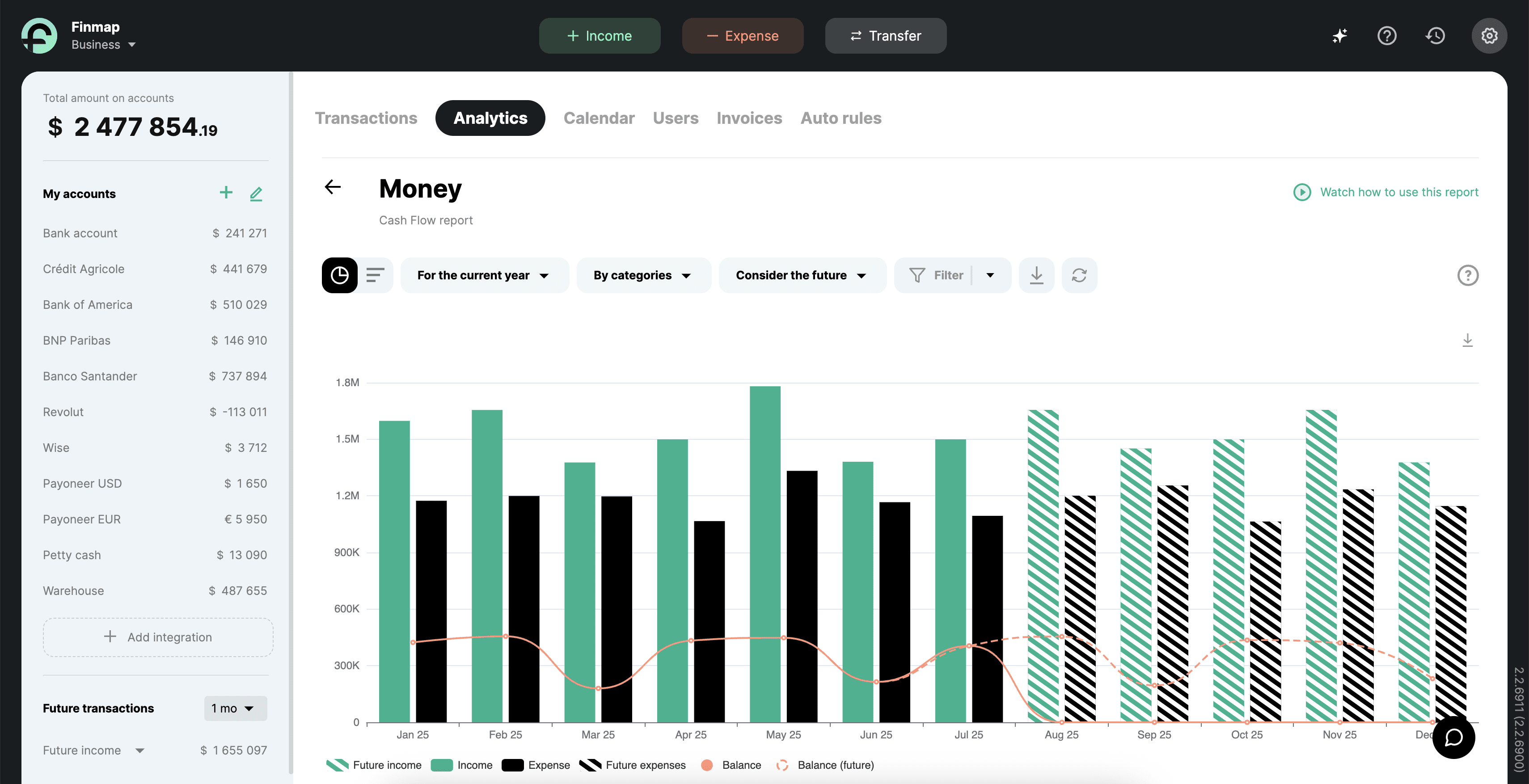
- Categorizing orders
To dive deeper, KLEI created a category structure in Finmap: separate categories for individual stickers and sticker packs. This revealed profitability by product type — not just at the business level, but by direction. They saw what to scale and what to rethink.
Before, we just looked at the total: money came in — so we were fine. But once we started dividing by order types, we saw that not everything was equally profitable. — Mykyta Anikanov, founder of KLEI
Developing Financial Literacy
Finances were Mykyta’s weak spot — the topic always made him anxious. Alongside Finmap, he completed the “Business Money” course. This allowed him to both delegate operations and personally understand how business finances work.
I used to constantly wonder — will everything add up, will there be enough? Now I understand where those questions come from — and how to answer them. — Mykyta Anikanov, founder of KLEI
Combining automation with personal involvement gave Mykyta what he needed most — confidence. He no longer relies on intuition. He makes decisions based on reports and real data.
This shifted not just the finances, but the entire business management approach.
A Financial System as a Prerequisite for Scaling
After configuring Finmap and delegating operations, the system became a steady anchor for the team. All key financial data was in one place, clearly structured by category, and accessible anytime.
This freed up time for what truly matters to a founder: growth, strategy, expansion.
So in 2025, KLEI reached a new level of scaling:
- Raised investment.
- Started building their own production facility.
- Opened new accounts.
- Launched a new financial structure aligned with their growth.
This growth would’ve been impossible without a working financial system already in place — they didn’t have to build from scratch.
When You Know the Numbers — You Know Where You’re Going
Next up: completing their production facility, stabilizing processes, and preparing to enter new markets. Finmap remains central — providing structure, control, and a foundation for every next move.
In the end, Mykyta offers a simple but practical takeaway:
Spend time on finances weekly. Even 30 minutes analyzing the numbers gives you more than guesses or gut feeling. A founder should know what every number means — and make decisions based on facts.
What You Can Learn from KLEI’s Story
Your business might resemble KLEI’s: a solid product, loyal customers — but inside, no clear view of expenses, constant cash gaps, and a lingering sense that something’s off.
KLEI stopped in time, looked into their finances — and saw the real picture. That gave them the confidence to scale, raise investment, and grow with clarity.
If you're reading this, you're probably on the path to financial clarity.
Here are a few lessons KLEI learned — so you don’t have to go through it blindly:
- No system = no control.
- Profit “by feel” = risk of a cash gap.
- Order in finances = not about Excel, but about automation, consistency, and the right tool.
Do what KLEI did: don’t wait for a crisis to get organized.
Try Finmap and see how business changes when financial clarity arrives.
Frequently Asked Questions
1. Why did a company with stable orders still face financial trouble?
Because orders ≠ profit. KLEI lacked a system to show what actually brings in money and what just adds turnover. This led to cash gaps and unclear costs.
2. What action creates immediate impact, regardless of industry?
Centralizing all accounts, income, and expenses in one system — and reviewing them daily in one window. This reduces chaos, brings clarity, and removes the risk of forgetting something.
For KLEI, that was the point where real control began. It works for any business, any niche.
3. Is Finmap suitable for small or creative businesses?
Yes. KLEI is a small business with a creative product. Such companies often operate on intuition. Finmap lets you stay creative — while seeing the real money.
4. What if I don’t understand finances?
Mykyta from KLEI wasn’t a finance expert either — and he says so. He delegated the bookkeeping, took a basic course, and learned to read reports. Finmap is made for founders who want clarity without getting lost in routine.
5. What results did KLEI achieve after organizing their finances?
They raised investment, launched their own production facility, built a new financial structure, and upgraded operations — all based on data, not assumptions.

Finmap AI Copilot: Your Financial Assistant for Automated Management and Analysis
Discover how Finmap AI Copilot helps entrepreneurs automate cash flow tracking, analyze reports, and make confident financial decisions—effortlessly.
Business is driven not only by numbers, but by the right decisions.
Getting a financial report is not the finish line.
The real challenge starts when you need to understand what those numbers actually mean for your business.
Cash flow increased this month? Is that really a good sign — or just an illusion of profitability hiding unpaid obligations or one-time income?
Keeping Up with Change — or Losing Everything: How AI is Transforming Financial Management
Today, technology doesn’t just store and structure your financial data — it helps you use it wisely.
Artificial intelligence can do in minutes what used to take hours of analysis and brainstorming: detect anomalies, uncover the true reasons behind financial shifts, and identify weak spots.
Imagine getting instant answers instead of spending hours crunching numbers:
- Why is profit down this month despite higher sales?
- Which client brings in the most money (and are they truly profitable)?
- Which department is draining the budget without delivering results?
- Will the company have enough cash for the next 3 months without additional funding?
This isn’t fiction — these are real scenarios Finmap AI Copilot handles daily.
If you’re tired of staring at numbers and still not getting answers — now’s the time to bring AI into your business.
Finmap AI Copilot: A New Era of Financial Management in Finmap
A new tool from Finmap, powered by OpenAI API. It’s a smart financial assistant that analyzes your reports, highlights key insights, and recommends solutions.
Designed for small and medium-sized businesses to:
- Quickly interpret financial metrics;
- See a clear picture of cash flow;
- Make decisions based on facts, not guesses.
Unlike basic chatbots, Finmap AI Copilot is a fully autonomous analyst that processes reports independently and delivers not just general advice — but specific, personalized analysis.
.webp)
Security First: How We Protect Your Data
Finmap AI Copilot was built with strict data protection in mind. We use the OpenAI API in a way that ensures your financial data stays private. What does that mean?
- Your data is not used to train AI models. We don’t give OpenAI permission to store or analyze your reports beyond the current task.
- Every request is handled individually. Once the answer is delivered, the data is deleted—no memory is retained between sessions.
- Your data is never shared with others or added to a “common database.”
In short: each time Finmap AI Copilot analyzes your report, it’s only for you, only now, and leaves no trace afterward.
Finmap AI Copilot — The Algorithm That Knows Your Finances Better Than You Do
Currently, Finmap AI Copilot structures its report in four main sections:
- General financial health overview: assessing the business’s condition and highlighting risks;
- Revenue and expense analysis: what drives profit and what drains resources;
- Benchmarking: showing how you stack up against market averages;
- Conclusions and recommendations: helping you move from analysis to action.
Based on your actual data, Finmap AI Copilot:
- Breaks down your cash flow: explains balance changes and what influenced transactions;
- Tracks profitability trends by month, category, and client;
- Identifies inefficient spending: recurring payments that don’t pay off;
- Highlights which products or services generate the most income—and which need reevaluation;
- Assesses risks and issues warnings;
- Advises on product mix and structure;
- Performs advanced P&L analysis automatically;
- Suggests concrete actions: what to cut, where to optimize, how to balance cash;
- Generates a top 10 actions list to improve financial performance.
Can Your Business Keep Up with the Competition? Find Out in Just 2 Clicks
Finmap AI Copilot doesn’t just analyze your data — it benchmarks it against the market average. This gives you the context to:
- Know whether you’re on the right track;
- See where and why you lag behind competitors;
- Understand whether market trends are affecting everyone — or just you.
For a small or medium business owner, it’s like having your own financial analytics team — but without the extra costs.
The Value of Finmap AI Copilot for Your Business
A structured solution that helps business owners react quickly, make informed decisions, and focus on strategy. Here's what you actually get:
Finance Automation in Action
Saves time and effort by auto-generating reports, highlighting what matters, and explaining the essence.
Works as a 24/7 Financial Assistant
Always available — no days off, no emotions, no human error. Ask a question, get an answer.
Brings Confidence to Decisions
Instead of guessing “Am I doing the right thing?”, you get facts, analysis, and actionable insights — right now.
Keeps You Focused on What Matters
Instead of drowning in reports, Finmap AI Copilot highlights critical issues so you can focus on solutions.
Breaks the Illusion of Profitability
Things may look good — but that might be deceiving. Finmap AI Copilot reveals the true picture.
Brings Order to Small Business Finances
Helps structure data, connect spending and income patterns across time — and build stability, not just survival.
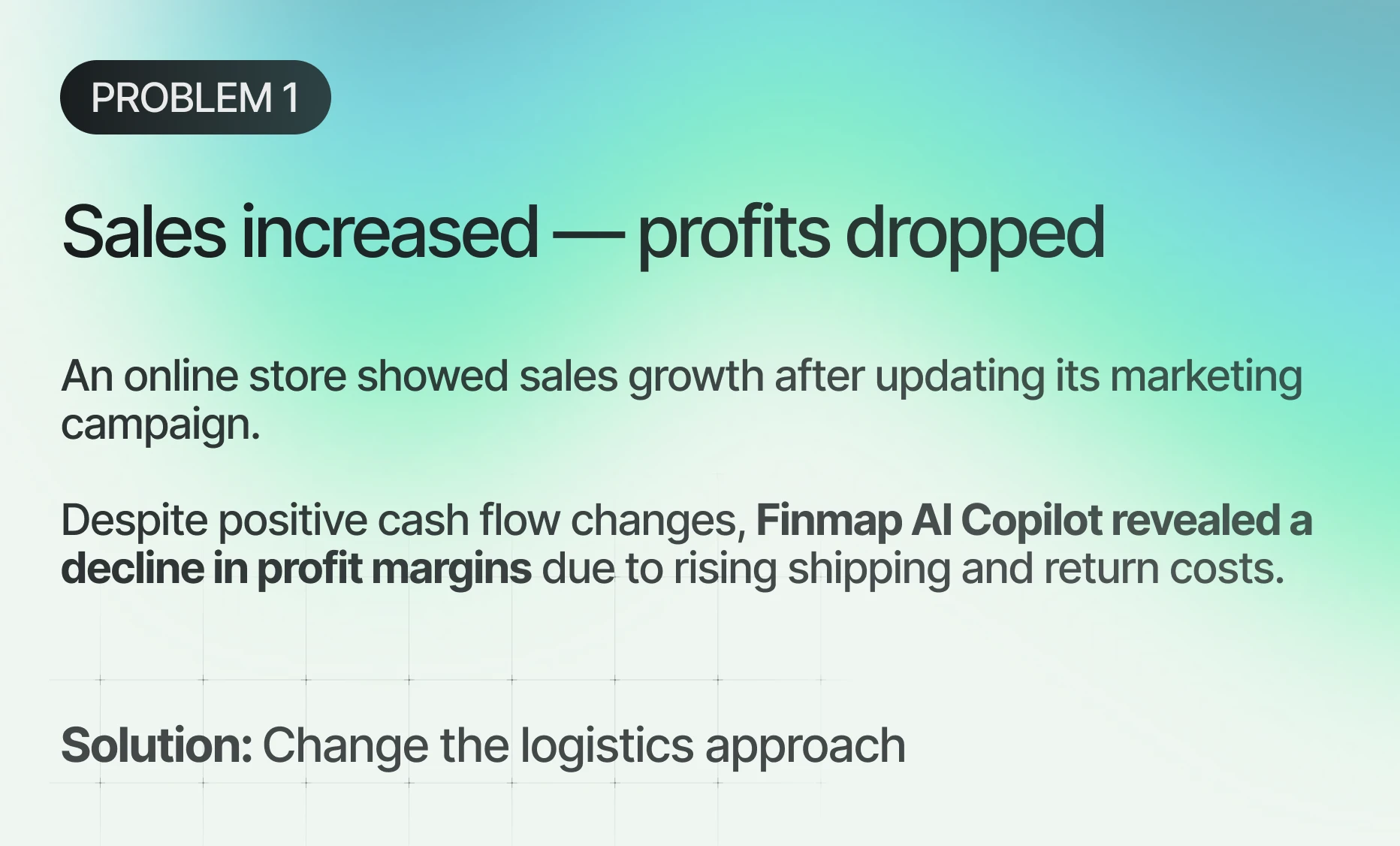
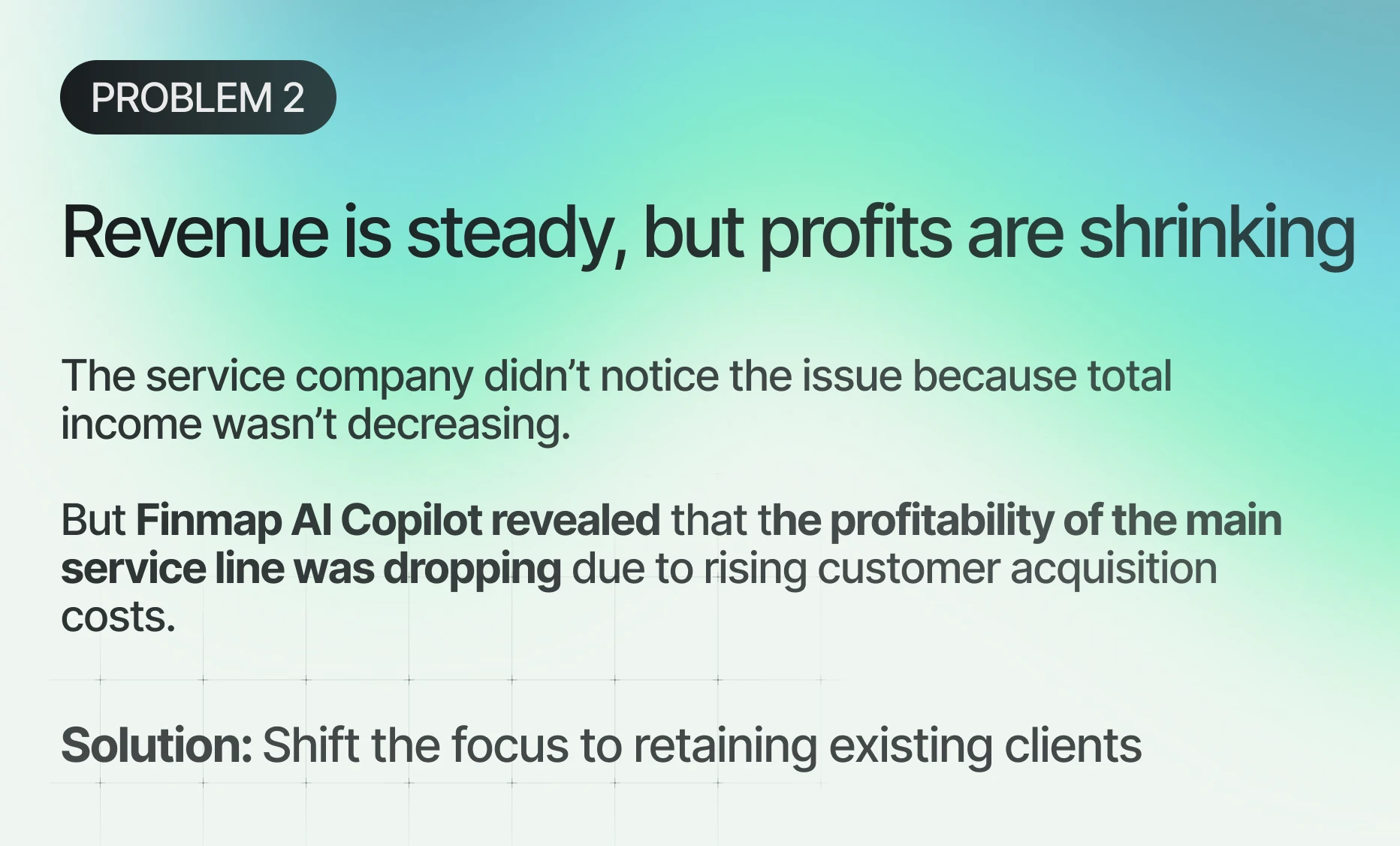
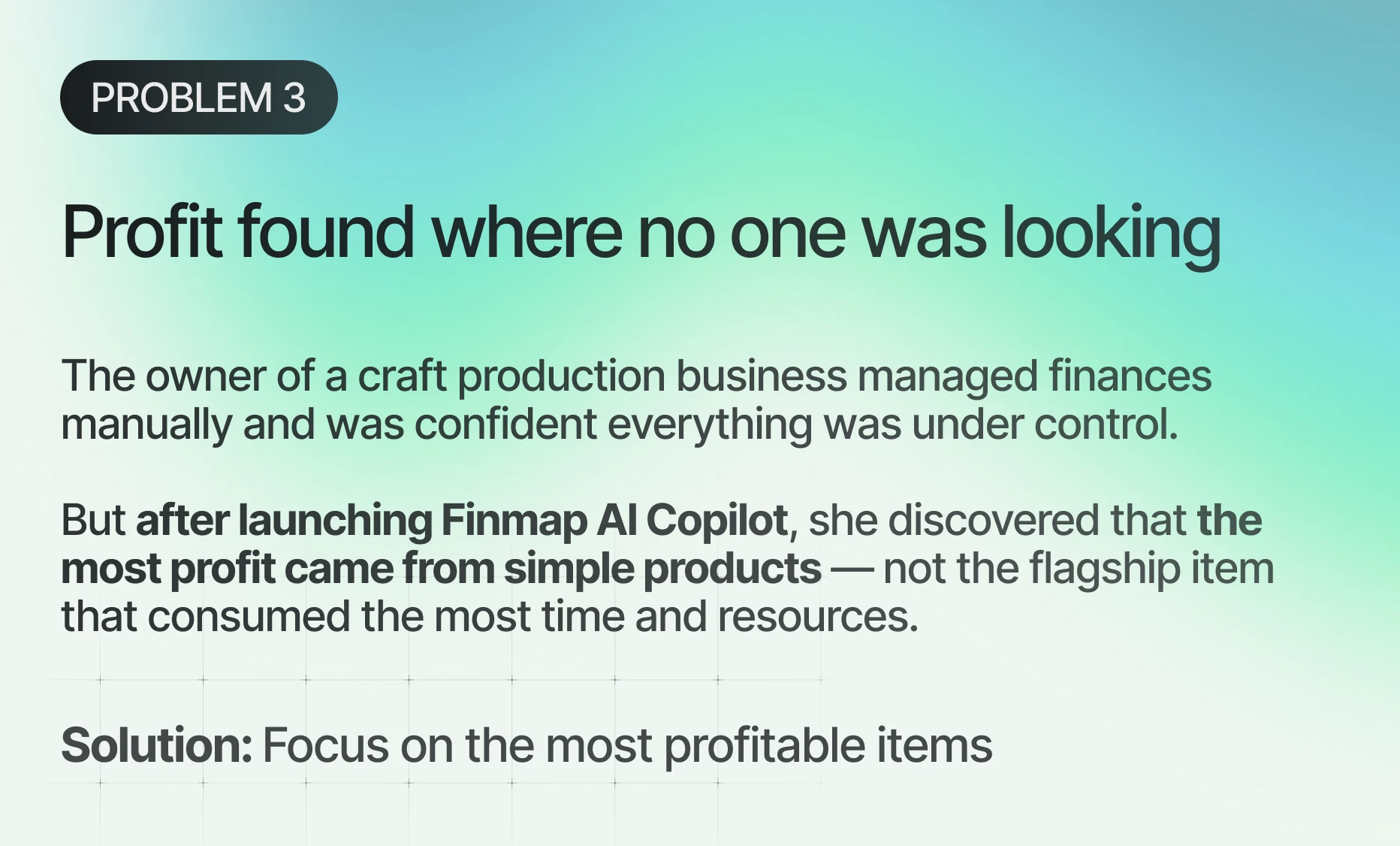
New Features Just Around the Corner
Finmap AI Copilot is already up and running — and constantly evolving. In fact, while you're reading this, new features may already be live, such as the ability to ask questions via text or voice, for example:
- Why did profit drop in July?
- Which expenses increased in Q2?
- Will I have enough cash for payroll through the end of the month?
It’s not just convenient — it’s the next level of financial management for small businesses. And savvy entrepreneurs are already using it.
Time to Act
Finmap AI Copilot isn’t just a feature — it’s a strategic advantage.
Where analytics and cash flow tracking once took time, energy, and experience, now all you need is your financial data — Finmap AI Copilot does the rest.
Already using Finmap? Test Finmap AI Copilot today.
New user? Sign up, add at least one quarter of data — and see it in action.
Business won’t wait. Start now!
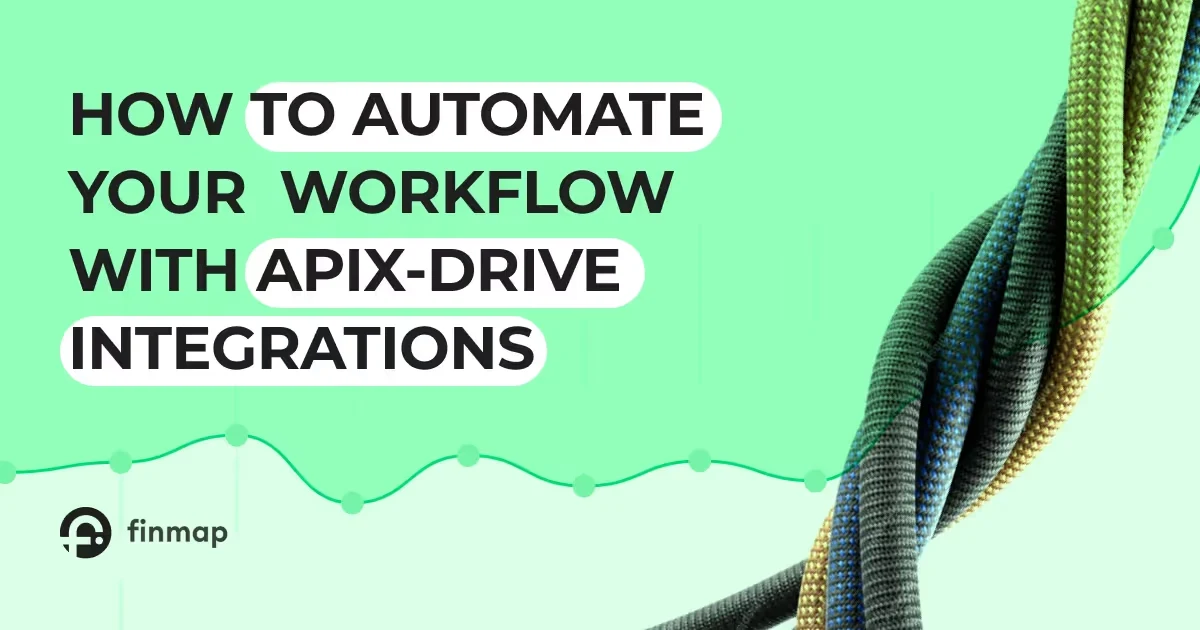
Workflow Automation: Key Integrations to Enhance Finmap's Efficiency
Automation saves time, reduces errors, and improves workflows by integrating different platforms
Automation of business processes is critical for the competitiveness of companies today. Implementing optimisation systems can significantly reduce the time spent on data processing, reduce the likelihood of human errors, and enable employees to focus on strategic tasks.
As the importance of this topic is constantly growing, we suggest you consider the main benefits of automation. In this article, we'll explain how platform integration ensures full automation of data transfer and share real-life examples of its use.
Benefits of Implementing Automation
Implementing automation in business processes has a number of important advantages. They have a direct impact on the efficiency, productivity, and development of an enterprise, regardless of its field of activity.
The most tangible benefits:
- Saving time and resources. Automation reduces the amount of manual work, freeing up time for priority tasks. By delegating routine to software algorithms, employees can focus on strategic tasks.
- Reduced errors. Manual data entry is always accompanied by the risk of errors. Automation reduces it, ensuring the accuracy and reliability of tasks.
- Increased efficiency. Automation of processes helps to respond more quickly to changes and customer requests and complete tasks faster. All this increases business productivity.
- Optimisation of workflows. Integration of different systems and platforms allows you to create more coherent workflows and effective interaction between departments and teams.
- Improved customer service. Automated processes make it possible to process customer requests quickly and efficiently. This increases customer satisfaction and loyalty to your business.
- Scalability. By implementing automation, you can easily scale your business processes without investing heavily in additional resources or staff. This is especially important for fast-growing companies.
Use of Online Connectors
Today, many different services are used to effectively automate business processes. Online connectors are one of the most advanced solutions.
These tools are used to integrate different platforms in order to maximise the transfer of work processes to the ‘automatic’ mode. They provide a simple and efficient connection between services and constant data exchange 24/7.

Let us consider how an online connector works using the example of ApiX-Drive. First, the user defines the data source, which can be any online service: CRM system, email, advertising account, etc.
After that, they select the receiver where the data will be transferred (for example, to a database, marketing platform, or other online tool). The ability to customise each integration in detail to meet the specific needs of the user makes ApiX-Drive stand out from other services. The final step is to specify the data update interval.
Advantages of ApiX-Drive:
- Ease of use: no programming skills required; quick setup of integrations thanks to an intuitive interface.
- Versatility: a large catalogue of systems and services that allows you to find solutions for automating a wide range of work processes.
- Automation: the elimination of manual data entry and errors that occur due to inattention or haste.
- Customisation: the ability to use filters, IF/Else logic, the AI TOOLS module, and other functions to customise the integration for specific tasks.
- Support and scalability: ongoing technical support and flexibility to scale workflow automation to meet new needs.
Integration of Finmap and KeyCRM

Integration of the KeyCRM platform with the Finmap helps automate business processes, improve cash management, and control over financial performance. Here are a few examples of use cases for this integration:
- Automation of financial reports. Every time a new order is added to KeyCRM or an existing order is updated, information about it is automatically transferred to Finmap. Thus, all orders are automatically reflected in financial reports. This simplifies the reporting process and allows you to get accurate revenue information faster.
- Control over expenses and income. Whenever KeyCRM receives new payments from customers or data on project costs, this information is automatically transferred to Finmap, where records of income and expenses are created. This ensures operational monitoring of financial flows, which helps to better control costs, compare them with expected revenues, and avoid financial problems.
- Analysis of the effectiveness of campaigns. Data on the revenue generated by each marketing campaign is automatically transferred from KeyCRM to Finmap. This allows you to analyse which campaigns are the most effective in terms of financial performance. This integration allows you to quickly assess the profitability of each campaign and optimise your marketing budget based on real financial data.
Integration of Finmap and Google Sheets

The integration of Google Sheets and Finmap is useful for businesses that need to automate financial data and reporting. Google Sheets in such a tandem can serve as a flexible tool for collecting and storing data, and Finmap as a specialised tool for financial management.
Here are some real-life case studies where this integration will bring significant benefits:
- Automatic tracking of receipts from clients. Example: A freelancer or small business uses Google Sheets to keep a list of clients and their income, and Finmap to manage their cash flow. Every time an entrepreneur receives a payment from a client, they enter the information into Google Sheets. Thanks to the integration, this information is automatically transferred to Finmap, where it is recorded as a receipt.
- Recording transfers and expenses for marketing campaigns. Example: a marketing agency uses Google Sheets to keep track of advertising and marketing campaign expenses, and Finmap to process this financial data. It enters all the data on expenses (amount, date, supplier) in Google Sheets. The integration automatically transfers them to Finmap, where they are recorded as expenses.
- Budget monitoring. Example: a family budget or the budget of a small organisation is kept in Google Sheets, and financial transactions are processed in Finmap. Data on monthly expenses, receipts, and transfers are entered into Google Sheets for storage purposes. The integration automatically exports this data to Finmap for further accounting and detailed analysis.
The results
Workflow automation is one of the most effective ways to optimise the modern business environment. It helps companies increase productivity, reduce costs, and scale their operations.
The introduction of online connectors such as ApiX-Drive greatly facilitates the integration of applications used in work and, consequently, process automation. This allows businesses to respond to changes faster and improve the quality and efficiency of their operations.
The positive effect is observed in both internal (interaction between employees) and external (interaction with customers) processes. As a result, businesses can quickly adapt to changing market conditions and strengthen their competitiveness.
And if you are interested in learning how to organise your business finances and see all the money and profit in clear graphs on one screen, Finmap specialists will be happy to help you.
.webp)
How a Publishing Agency Eliminated Cash Gaps and Boosted Profits by 10%
Do you ever feel like your business is stuck in a cycle of constant financial difficulties? We know how difficult it can be to run a business in an uncertain environment. Especially when cash gaps and recurring losses hinder growth.
However, there is a way to change the situation for the better. Find out how a publishing house and educational projects managed not only to overcome financial difficulties but also to achieve a 10% monthly profit growth.
Losses and uncertainty: what to do?
Our client, a well-known publishing house with educational projects, faced the following problems:
- Cash gaps
- Constant losses
- Inefficient reinvestment
- Ineffective investments in new projects
- It was difficult to determine which products were profitable and which were unprofitable.
These risks posed the threat of bankruptcy, poor management decisions, and investing resources in unprofitable products.
How Finmap's financiers changed the situation
We started with a detailed analysis of profitability to determine which areas of activity were profitable and which were unprofitable. Then we implemented a systematic control of financial indicators with Finmap, which allowed us to track the financial position in real time.
Impressive results of cooperation
Thanks to the cooperation, the client achieved the following results:
- Complete absence of cash gaps
- Effective financial management
- Financial modelling of new projects
- Competent management of investments and reinvestment of profits
- Profit growth by 10% per month from the second month of cooperation
New financial structure and investment policy
We helped to create a clear financial structure for the business, reduce staff costs and increase efficiency. An effective investment management policy was also implemented, which significantly increased the profitability of the projects.
What kind of entrepreneur do you want to be?
Are you ready to get rid of financial difficulties and reach a new level of business development? At Finmap, we are committed to helping you achieve this. Our team of financial experts is ready to provide the support you need to optimise your business:
- Analysing the profitability and profitability of projects
- Implementation of a financial performance control system
- Effective financial and investment management
- Development of an individual financial strategy
Take the first step towards the stability and growth of your business. Let's get your financial affairs in order together!

Scaling Your Business Smoothly: A Cash Flow Management User Case in IT Recruitment
Most entrepreneurs agree that scaling a business is always a challenge, accompanied by the possibility of chaos and failure. Yet, the hero of our today’s case study, Andrii Oleksiienko, the founder of Storypoint, does not agree at all
.webp)
User case card
Storypoint — IT recruitment company
🌐 Website: https://storypoint.team/
Andrii Oleksiienko — Co-founder & CEO of Storypoint
Knows how to build cool teams in IT companies.
His goal is to improve the recruitment process in Ukraine.
Does not like to manually enter data into spreadsheets.
📱 Insragram: @alex__andrew
Most entrepreneurs agree that scaling a business is always a challenge, accompanied by the possibility of chaos and failure. Yet, the hero of our today’s case study, Andrii Oleksiienko, the founder of Storypoint, does not agree at all. 😉
He managed to scale his business in one year and increase his income almost tenfold while avoiding financial losses and mistakes. He did it with systematic cash flow management, of course (otherwise why would we be here, right?). In this case study, we tell you how cash flow management helped Storypoint and how you can adopt their experience for your business.
Given
Storypoint was created by Andrii and his partner Diana in 2021. It helps to recruit and hire talented people for technology companies, as well as facilitates outsourcing and outstaffing in Ukraine and abroad.

Prior to launching his business, Andrii worked in IT-companies and built teams from within. Therefore, he knows well what problems both business leaders and employees face.
For the first 2-3 months of work, the company used spreadsheets to manage finances. However, as the business grew, so did the expenses. They had to dedicate extra effort to enter each transaction into the spreadsheet, and eventually the task became too time consuming. Andrii started looking for ways to automate the processes.
The problem was that all transactions had to be entered manually into our Spreadsheet, where the entire budget was stored. It took a lot of time, so we decided to automate the process and that’s why we chose Finmap. — Andrii Oleksiienko, Co-founder & CEO of Storypoint
Task
When choosing a solution for automation of cash flow management, the following was important to Andrii:
- Financial management should not be time consuming. Business owners and finance managers have enough operational tasks every day. He didn’t want to spend more hours on entering all the transactions manually.
- It must be possible to connect bank accounts into the cash flow management tool, in order to save time on entering transactions, as well as to avoid losing costs. It was especially important for Andrii to be able to connect the tool with Monobank, because the company’s account was with this bank.
- Clear analytics for systematic understanding of the company’s expenses and incomes.
Finmap solution
Andrii learned about Finmap from friends. At that time the tool was still in beta testing, but the businessman was not intimidated and decided to give it a try. The crucial factor for Andrii was the possibility to link Finmap with the bank so he would not have to enter all the transactions manually.
One of the reasons was that we have Monobank, and Finmap works with Monobank. It was perfect. Because such an integration between a bank account and Finmap is exactly what we use it for, it’s a major feature for us. — Andrii Oleksiienko, Co-founder & CEO of Storypoint
Implementing Finmap: Was it difficult?
It was not difficult at all. The implementation of the service did not take long. All that was needed was to register, create a company and connect the bank accounts*.
Finmap has the coolest onboarding. I signed up for the service, linked the company’s Monobank account, and imported all our transactions. — Andrii Oleksiienko, Co-founder & CEO of Storypoint

* This is what the features of connecting integrations with banks and services inside Finmap look like. Integrations with 2000+ banks around the world are now available in Finmap.
Setting up finance management: Maybe this was difficult?
At the time Storypoint connected to Finmap, the service was still in beta. That’s why Andrii did face some difficulties with the currency conversion*. Payments in USD and EUR that came to the company were not always displayed at the correct exchange rate.
There was only a few cents difference, but because of that discrepancy the debit and credit didn’t add up. — Andrii Oleksiienko, Co-founder & CEO of Storypoint
* Now, Finmap pulls current exchange rates from national banks of different countries. For example, for Ukraine from the National Bank of Ukraine, for the Czech Republic from Czech National Bank, as well as from Mastercard.
This means that for users who have transactions in different currencies, information about exchange rates is always accurate. In addition, it is possible to set your own exchange rate if needed. This, for example, is how the exchange rate is displayed when you enter Income in USD into a UAH account.

To solve it, Finmap offered Andrii the advice of our financial expert*.
The finance expert showed our accountant how to properly structure income and expenses in Finmap. After that, all the statements added up perfectly. Plus, they helped us correctly organize everything, add categories, subcategories, tags. Since then, we are able to analyze our expenses and income in different categories: per employee, per project. That, in turn, helped optimize costs and drop unprofitable projects. — Andrii Oleksiienko, Co-founder & CEO of Storypoint
* If you prefer, our users can get help from Finmap’s financial experts and choose an assistant, manager or mentor for themselves. You can book free consultation and find out more about this service.
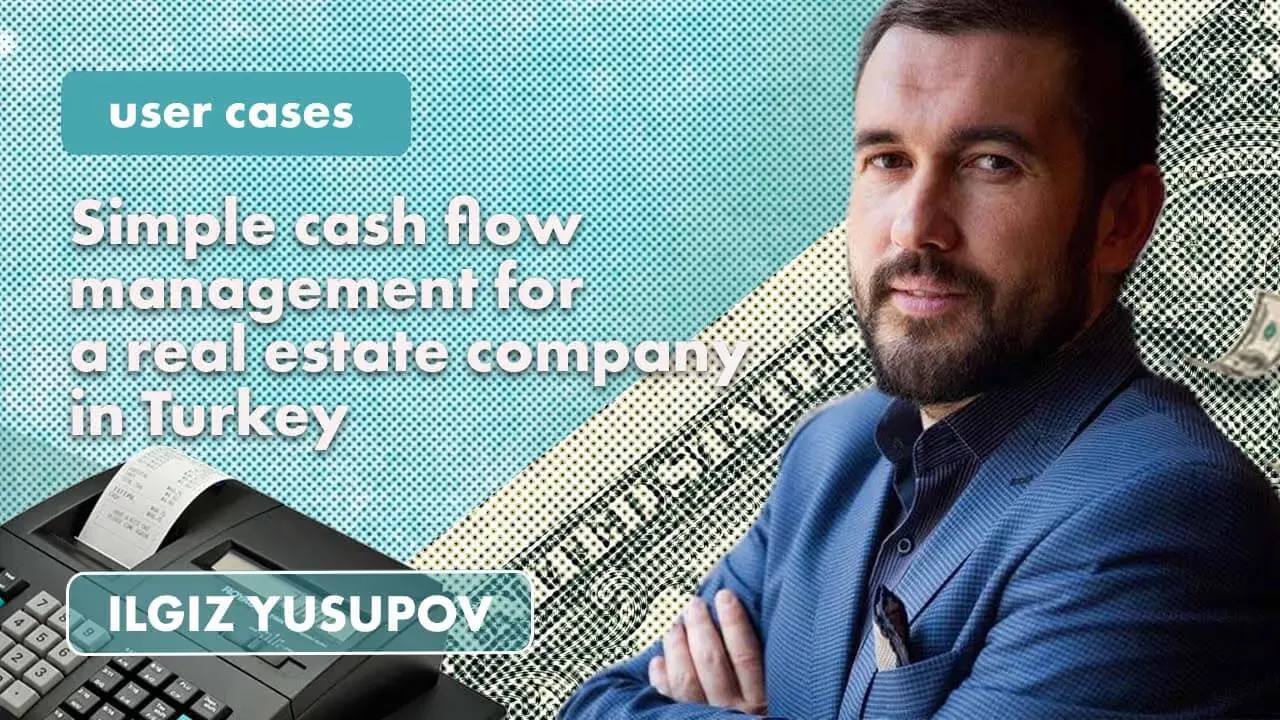
How a Turkish Real Estate Company Turned Cash Flow Management into a Competitive Advantage
Company «AIRT» — Turkish Association of Independent Realtors, sells and rents property in Turkey.
.webp)
User case card
Company «AIRT» — Turkish Association of Independent Realtors, sells and rents property in Turkey.
Website: https://airt1.com
Ilgiz Yusupov — founder of the company «AIRT»
Instagram: @ilgizyusupov
For 7 years he has been involved in real estate in Turkey.
Has been using Finmap in his business for about a year.
For him, cash flow management with Finmap is an opportunity to reflect on his company’s financial health and plan for the future, while quietly enjoying a cup of coffee.
Best price, caring service, high quality… What other advantages can a business use to get ahead of the competition?
One Finmap user, the founder of a real estate company in Turkey, realized that orderly business finances could also help him get ahead. Why and how? We tell you in this user case study.
Given
AIRT deals with real estate in 4 cities in Turkey (Istanbul, Antalya, Alanya, Ankara). AIRT’s core business is the sale of flats in new buildings. However, they also deal with rentals, commercial properties and secondary housing.
There are now 12 employees in the team. But as Ilgiz, the company’s founder, says:
All of our brokers are independent individuals with their own life stories. They are not employees, but partners. — Ilgiz Yusupov, founder of the AIRT
The company has a turnover of about $1 million a month. Ilgiz has ambitious plans for the business:
- To develop the company in other cities in Turkey and around the world.
- To make the property market more professional and reduce the level of fraud.
Among other things, the Association of Independent Realtors was set up for this purpose.
Our aim is for the Association to be at a national level. We hold broker conventions and create workable rules in the market, so people can understand what is effective and what is not. — Ilgiz Yusupov, founder of the AIRT
In order to work systematically towards these goals, Ilgiz, as the founder and manager of the company, needs to understand exactly what is happening in the business and make informed decisions. So, he decided to introduce financial management.
Task
Ilgiz was immediately looking specifically for a financial management tool. He already knew that just accounting was not enough.
I was purposefully looking for a financial tool. Because in Turkey an accountant deals with many things, but not with finances. He does some invoicing, some tax calculations, but he doesn’t keep the finances. As a result, there is no way to understand where there are expenses and where there is income, even by using Excel. — Ilgiz Yusupov, founder of the AIRT
It was important for him to:
- Clearly understand what the company’s expenses are and how much revenue the business generates.
- Keep track of this data regularly and, preferably, have it all in one place.
I needed one programme where I could go in and clearly see the main indicators I needed in dashboard form, especially income and expenses. In general, any entrepreneur needs to understand income and expenses at least once a week. This helps to make decisions in terms of saving or, hopefully, expanding. — Ilgiz Yusupov, founder of the AIRT
He found out about Finmap by chance: I came across an advertisement, looked at the information about the service and immediately began to implement it.
Finmap solution
Ilgiz manages cash flow in his business on Finmap by himself, without delegating to the staff.
Finmap is an enjoyable activity for me. I try to set aside an hour or two a week, brew some fresh coffee, sit down and enjoy doing it. — Ilgiz Yusupov, founder of the AIRT
So far, all the data is entered manually, including the company’s expenses and income. There are only 3 buttons in the service for entering transaction data: Income, Expense and Transfer. It is therefore easy to understand at a glance.
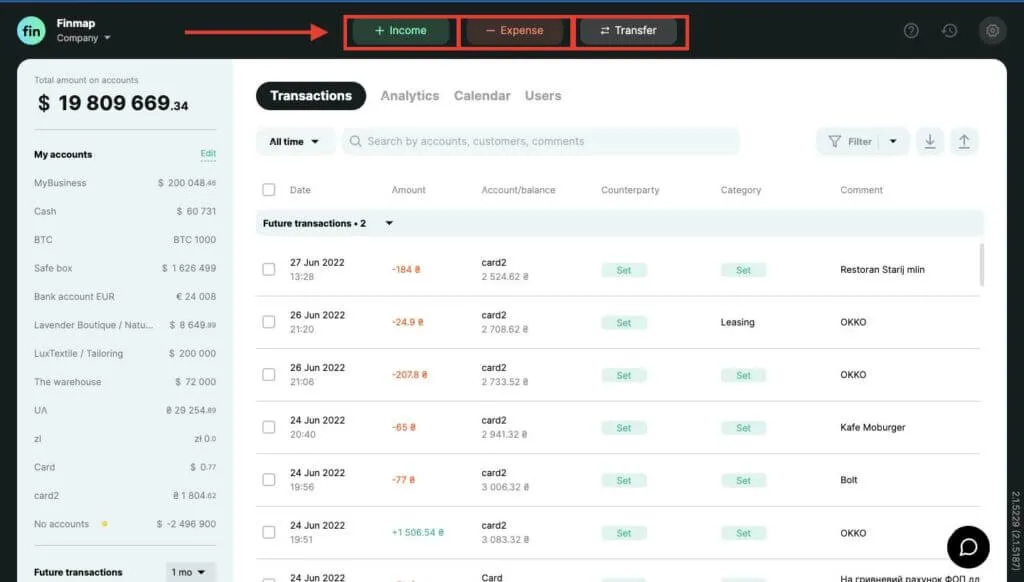
To make the analytics clearer and more accurate, user can specify not only the amount, when entering transactions, but also:
- Category — the type of income and expenditure, e.g. targeted advertising expenditure, income from renting commercial real estate.
- Counterparty, i.e. from whom income is received or to whom the company has made the payment — expense.
- Tags — further option to specify the data on the transaction. For example, you can add tags with brokers’ names so that Finmap can then filter out all revenues that came from a particular broker in its reports.

Since Ilgiz started using Finmap, we have added integration with Turkish banks, including Akbank Direkt, DenizBank, Garanti, Ziraat Bank and Yapi ve Kredi to Finmap.

This will help our users from Turkey and those with Turkish bank accounts save time. Thanks to the integration, all bank account transactions (receipts and expenses) will go into the service automatically and manual entry of transactions will not be necessary.
The most important report for Ilgiz now is Money (Cash Flow)*. It shows cash flow and allows us to systematize what amounts are received and what amounts are spent by the company.

Ilgiz can now clearly see on one screen all revenues and expenditures of the business comprehensively or by specific parameters. For example, he can filter income by Category, «Sales in new buildings».

It’s so convenient and easy to read. Before I would get dizzy trying to understand endless columns on spreadsheets. When deals go through and you start increasing your staff or buying some additional software without checking your financial records, there are consequences. In this respect Finmap is a wakeup call, alerting me to my business’ finances. — Ilgiz Yusupov, founder of the AIRT
Ilgiz is still exploring how Finmap’s other reports can help his company (Profit (P&L), Projects, Accounts Receivable, Accounts Payable).
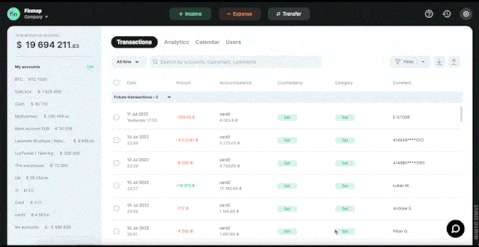
His plan for the future is to get additional training in order to gain a deeper understanding of finance to make the most of financial management.
What is the result
Finmap is absolutely the right thing to do. — Ilgiz Yusupov, founder of the AIRT
- All company income and expenses are now organized. They can be analyzed at any time without wasting a lot of time and without waiting for reports from the accountant/finance director.
It literally takes five minutes. I go into Finmap, look at my expenses and my income. That’s it. It really helps. — Ilgiz Yusupov, founder of the AIRT
- It has become easy to make decisions based on numbers, not to inflate costs where they are unnecessary, but also not to save too much.
It’s just the kind of time when I can reflect a little bit on the numbers, see what’s going on. Because in the hustle and bustle of everyday life, you don’t see what’s going on. But when you sit down and look at the numbers, and they are in a convenient format, everything is clear. — Ilgiz Yusupov, founder of the AIRT
- Ilgiz realized that he could increase his advertising budget without falling into a cash gap (a situation where a business temporarily lacks money to cover expenses).
- Systematic cash flow management has become a competitive advantage for the company.
Of course, this is a competitive advantage. Because if 50% of the market does not use cash flow management, they will get into financial holes, recruiting a large number of employees or increasing money for advertising when they can’t afford it. In the meantime, I can pull ahead by making sound financial decisions. — Ilgiz Yusupov, founder of the AIRT
It is now much easier for the Association of Independent Realtors to move towards the goal.
The plans for the future are for the Association to become a place where every foreigner can come, not just to buy a property, but to find one specifically tailored to their needs and objectives. — Ilgiz Yusupov, founder of the AIRT
We are sure that with such a systematic money order everything will surely work out.
If you too are setting ambitious goals for your business, you need a well-thought-out plan and a clear picture of your company’s financial situation.

How Present Perfect Agency Manages Finances in a Small Business: A User Case
Present Perfect Agency is a language services agency that helps businesses with translations, support, business documentation and everything related to languages.
.webp)
User case card
Present Perfect Agency is a language services agency that helps businesses with translations, support, business documentation and everything related to languages.
Website: https://presentperfect.agency/
Facebook: @present.perfect.translations
Olena Mironik is the founder and head of Present Perfect Agency.
She first used Finmap while working for an IT recruiting agency.
In her business she has been keeping track of finances in Finmap since the first day.
Olena likes to keep track of money, especially when it comes in.
In your opinion, when does a business need to implement cash flow management?
- After the cash gap, so as not to repeat the experience.
- When profits fall, to find the cause.
- When the business gets big enough.
- Before the cash gap occurs in order to avoid it.
Of course, it is never too late to implement cash flow management, but ideally a smart entrepreneur will have a system for accounting for money from the first day of business. Olena, the founder of the language services agency Present Perfect Agency, agrees with this.
From the very first transaction, I started keeping all the records in Finmap. — Olena Myronyk, founder of the Present Perfect Agency
In this case study, we explain why even though she runs a small business, Olena decided to keep system accounting right away and how Finmap helps her.
Problem
Originally, Olena worked at an IT recruiting agency, but at the end of 2020 she decided to strike out on her own and founded the Present Perfect Agency. Both then and now she trusted Finmap to account for business money. Why?
The deciding factor to try Finmap was its simplicity.
Olena learned about the service from Alexander Solovei (co-founder of Finmap), whom she had known for a long time. She saw on social networks that he was developing a solution for cash flow management. Therefore, when the IT recruiting agency had the task of accounting, Olena immediately decided to try the product.
Before that, she had analyzed services to automate processes. However, she found only solutions suitable for large businesses, which were too complicated and expensive for a small company. Finmap, on the other hand, was simple, straightforward, and accessible.
When Olena decided to start her own business she knew from experience that she wanted to use Finmap to keep records.
Task
Olena had no difficulty in keeping a financial account. But there were three key tasks:
- Accounting shouldn’t take a lot of time. Olena knew that she was already going to be spending a great deal of time getting her business off the ground and didn’t have extra time to spare manually maintaining spreadsheets.
The lack of scalability, the manual operations, and the limitations in the amount of data make the whole process around an Excel spreadsheet quite time-consuming. — Olena Myronyk, founder of the Present Perfect Agency
- She wanted simple to use and easy to understand data:
Both Excel and Google spreadsheets require a certain amount of expertise. Every time I needed to calculate new values I had to reopen Excel, perform manual operations and recalculate. I didn’t start my business to become a spreadsheet expert. — Olena Myronyk, founder of the Present Perfect Agency
- Keeping records in one place. At her job at an IT recruiting agency, Olena encountered situations where she had to give someone access to a spreadsheet. But at the same time she didn’t want to open all the data. As a result, she had to create copies of the tables. Of course, afterward they got mixed up, and the meaning and logic of their maintenance was forgotten. It was easier to burn everything and start all over again, than to figure out what was what.
The Decision to go with Finmap
I’m glad I don’t have to use some big-business solution and try to bolt it onto the smaller projects I’ve had to work with. — Olena Myronyk, founder of the Present Perfect Agency
After analyzing the financial accounting at her former places of work, Olena noticed that many important indicators were not taken into account. In Finmap, she started entering absolutely all data, including hosting and email costs. She categorized expenses and incomes*. In this way a system appeared and payments stopped getting lost.

* Categories in Finmap allow you to designate types of income and expenses. This helps you keep track of income and expenses in each specific type. For example, how much a company spends on Facebook ads, how much it earns on one particular project.
When she started her business, Olena also set up accounting by categories right away. Present Perfect Agency has a small number of fixed costs (e.g. software for translators), as well as variable costs for paying translators depending on the projects.
All expenses can be planned in advance and tracked in the Payment Calendar* to avoid cash gaps.

* The Payment Calendar in Finmap displays all scheduled receipts and expenses by date. For example, you specify that you pay $500 in office rent each month on the 17th. The payment calendar will note each month on the 17th that you have $500 to spend.
Olena also finds the account panel very helpful. Present Perfect Agency clients pay to accounts in Ukraine, foreign banks, personal cards, cash, and can even do it in cryptocurrency.
All actual information about the amount of money in the accounts is displayed in Finmap. Olena doesn’t have to go to each bank and wallet separately. She can see at any time how much money is on hand and where it is exactly in the company right now.
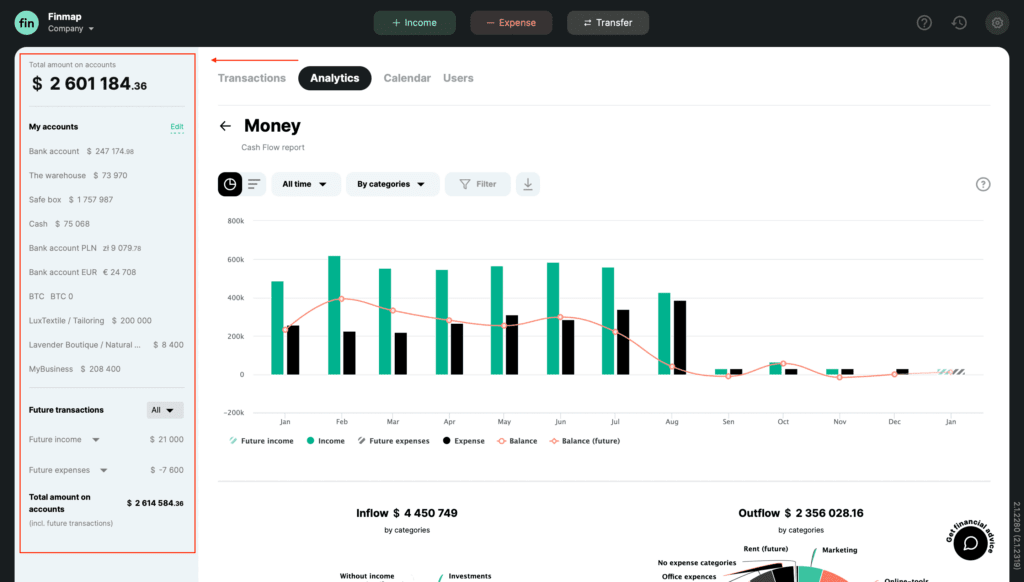
It is also important for Olena to keep track of the movement of funds, to understand where they are coming from, and where they are going. The company has accounts in different currencies, not only in Ukraine but also abroad. The “Money (Cash Flow)”* report helps her in this.

* The “Money” report in Finmap shows your cash flow. It allows you to see how much money is coming into the company and how much is being spent.
Another key report at Present Perfect Agency is the “P&L “* report. With its help Olena can identify profit for a certain period, which departments are generating profit, and where she is incurring loss.

* P&L report is a profit and loss statement. Shows the company’s profit and loss for a certain period, for example, a month. To do this, all expenses for the same period are subtracted from all income for that period.
It is also important to Olena that she can enter all the data in just a few minutes, not only from her computer, but also through a Telegram bot. Therefore, the information is not lost and is always as up-to-date as possible.

Because business has been going well, Olena recently hired an assistant. As a result she is now able to delegate some of the record keeping. With Finmap it is easy to set restrictions and choose what information the employee can add, what information can be viewed, and what information is reserved for Elana’s eyes only. This means she doesn’t have to make copies and create chaos in accounting for the sake of confidentiality.

As a result
It’s that headache you take off yourself and you don’t have to think about it along with the other issues in the OP that come up every day. — Olena Myronyk, founder of the Present Perfect Agency
- When Olena worked for an IT recruiting agency, she learned that Finmap was an efficient, easy-to-use system for recording money. She saw that with Finmap not only was incoming money from clients and expenses for recruiters’ bonuses recorded, but also many fixed costs, such as hosting fees, corporate e-mail, etc. were organized and easily accessible. This past experience was the reason she chose Finmap when she opened her own company.
- It is convenient for Olena to create useful reports. Finmap itself generates them on the basis of the data entered in the form of clear charts and graphs. Reports can be exported to PDF or Excel.
In our last job (at an IT recruiting agency), we had a tradition of managers also reporting to employees. And, of course, it’s convenient when you can just upload a PDF and that’s it. — Olena Myronyk, founder of the Present Perfect Agency
- A systematic accounting of finances is also set up at the agency. Olena sees at any time how much money is in each account, which payments from clients have been received and which are pending, how much has been spent, and what payments are planned.
- Accounting takes minimal time. This is especially important in a small business when the owner has many tasks on a daily basis and no large team to delegate to.
Everything is in front of your eyes, you press 2-3 buttons, and you can enter/receive all the information. — Olena Myronyk, founder of the Present Perfect Agency
- To enter data, all you have to do is use a Telegram bot. That is why nothing is lost, because you can add incoming or outgoing data even when standing in traffic or drinking coffee.
- And most importantly, Olena notes, thanks to Finmap there is:
An understanding of where we are going, how we are developing, whether we are scaling and what is worth paying attention to.
Connect Finmap to implement systematic cash flow management and see the full picture of your business at any time.
You can learn more about the Present Perfect Agency at: https://presentperfect.agency/

